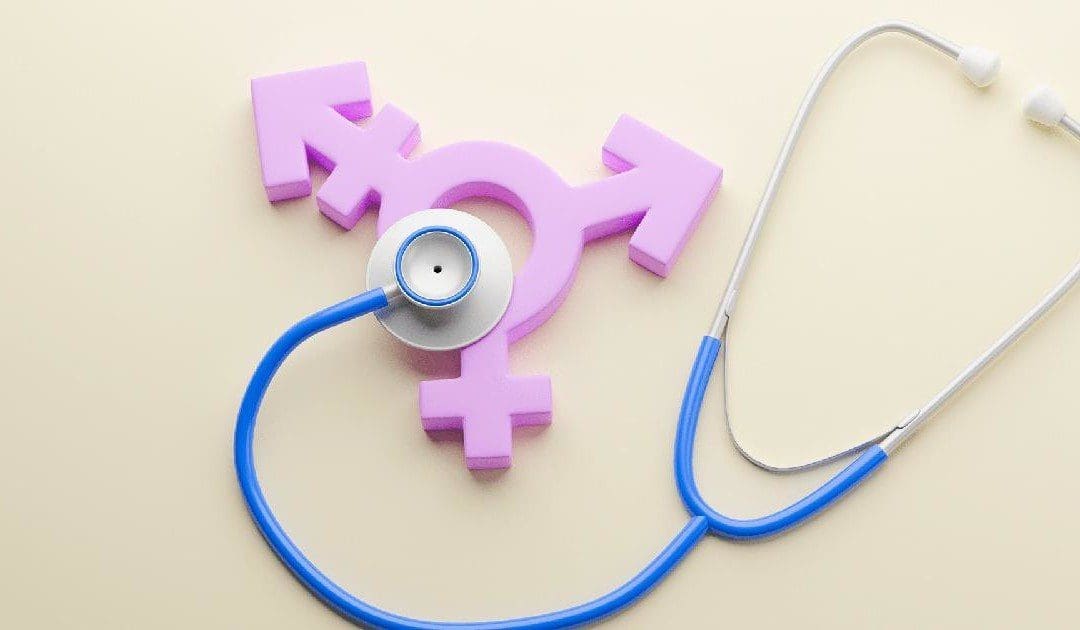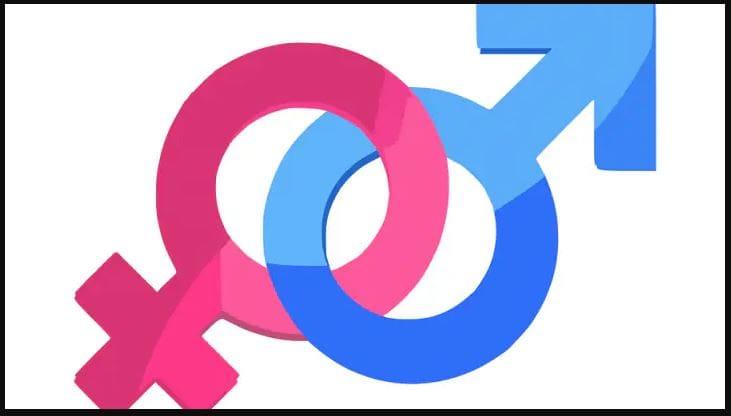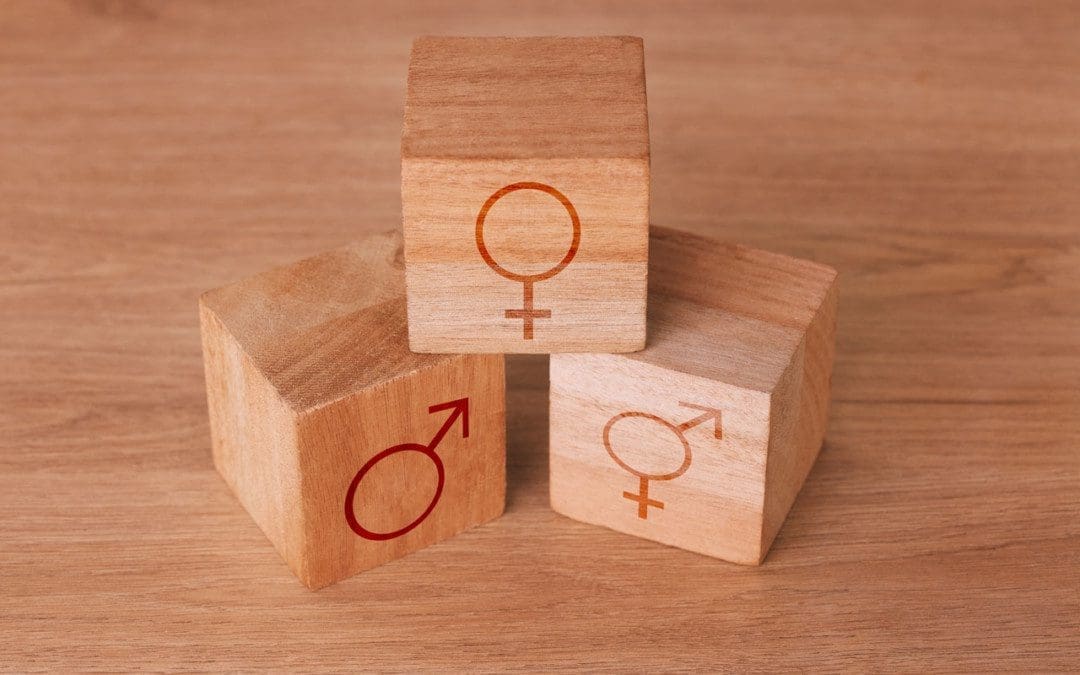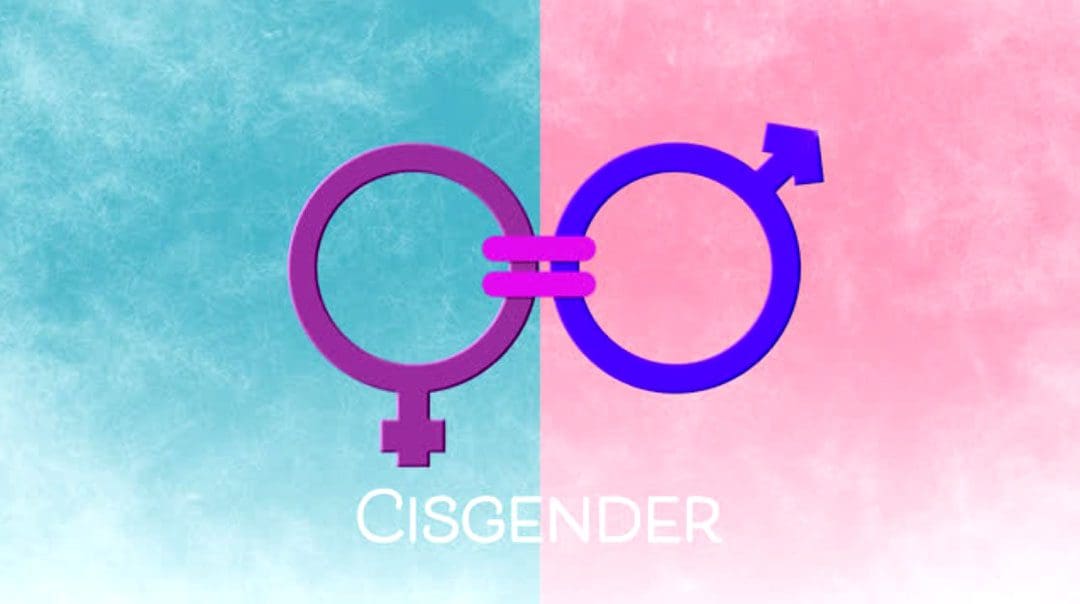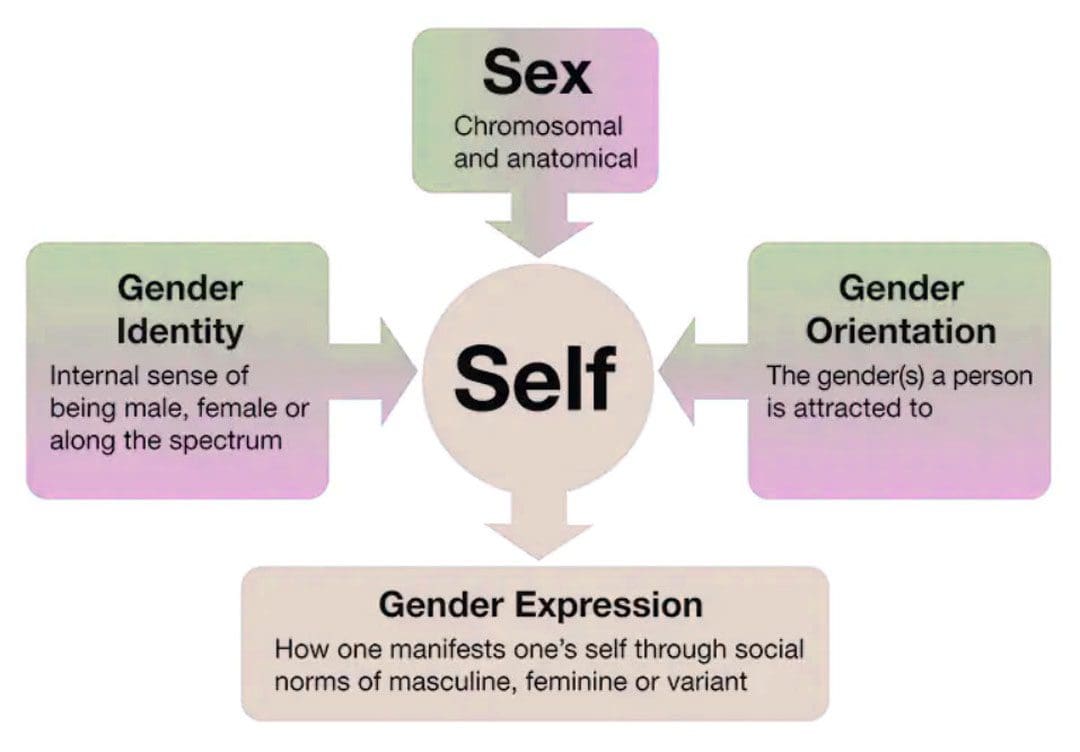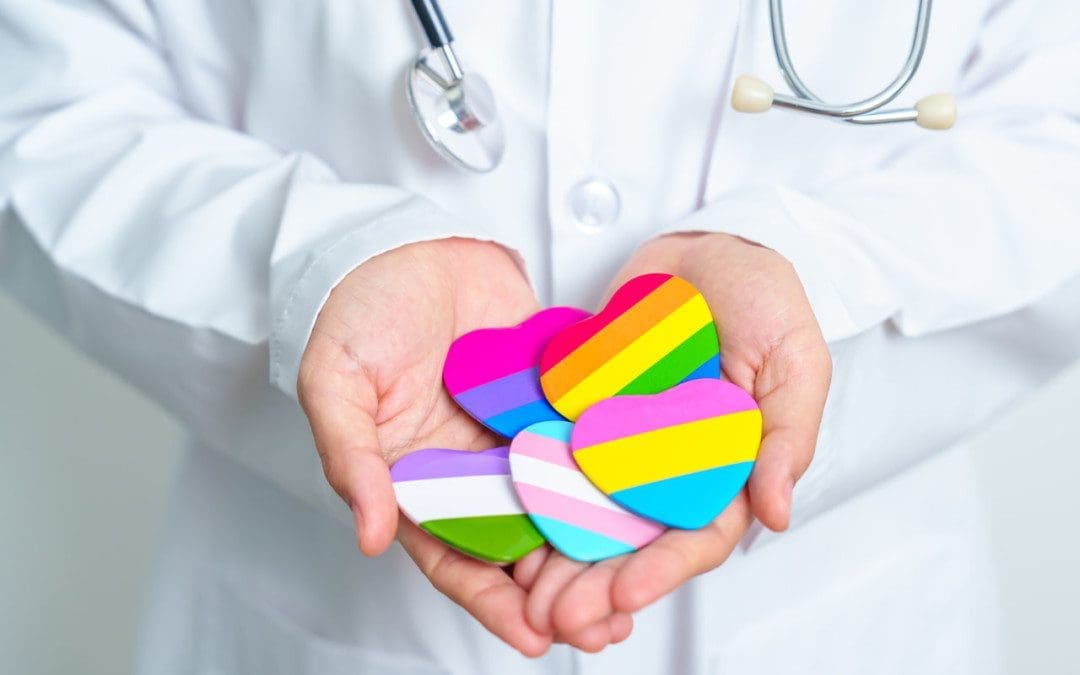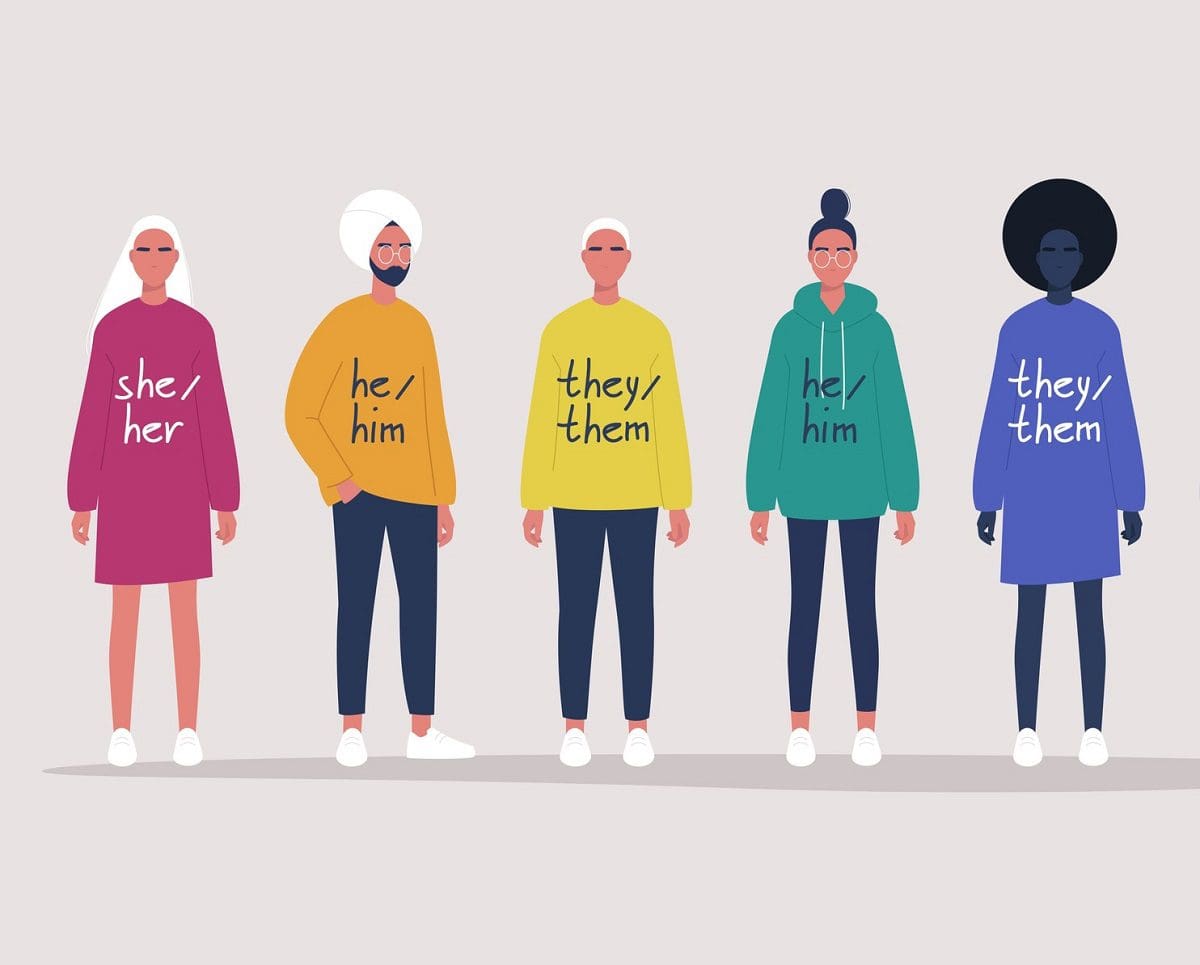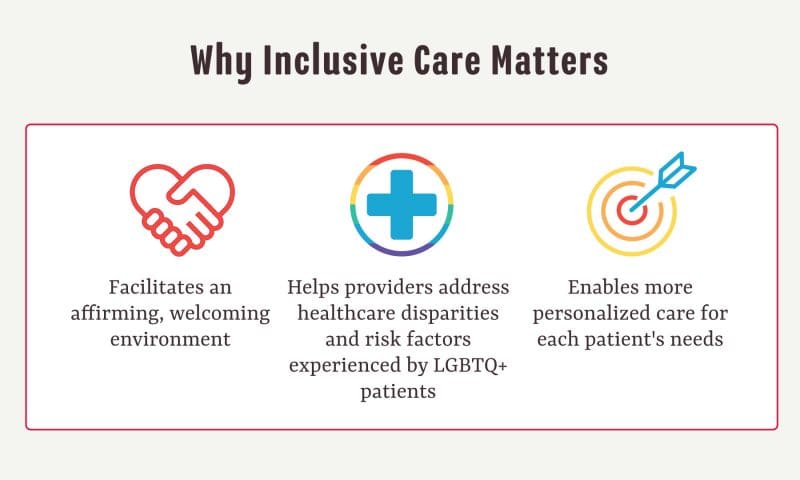ការបញ្ជាក់ពីយេនឌ័រ ការថែទាំសុខភាព
ការស្វែងរកអ្នកផ្តល់សេវាថែទាំសុខភាពដែលបញ្ជាក់ពីយេនឌ័រអាចជាការពិបាក។ អ្នកផ្តល់សេវាជាច្រើនខ្វះចំណេះដឹង និងការបណ្តុះបណ្តាលលើតម្រូវការ និងបទពិសោធន៍ អាចជាការរើសអើង ហើយជារឿយៗមិនមានការចង្អុលបង្ហាញនៅពេលចូលទៅក្នុងកន្លែងដែលអ្នកផ្តល់សេវាបញ្ជាក់ពីយេនឌ័រ។
ការថែទាំដែលបញ្ជាក់ពីយេនឌ័រ គឺជាការថែទាំដែលសមាជិកនៃសហគមន៍ LGBTQ+ មានតម្រូវការរបស់ពួកគេបំពេញបានត្រឹមត្រូវ មានអារម្មណ៍សុវត្ថិភាព និងផាសុកភាព និងមានអារម្មណ៍ថាយេនឌ័ររបស់ពួកគេត្រូវបានគោរព។
លោកវេជ្ជបណ្ឌិត Alex Jimenez (គាត់/គាត់) ជឿថាសមាជិកនៃសហគមន៍ LGBTQ+ ត្រូវបានប្រព្រឹត្តដោយការគោរព សេចក្តីថ្លៃថ្នូរ ហើយសំខាន់ជាងនេះទៅទៀត ធានាថាពួកគេទទួលបានការថែទាំវេជ្ជសាស្រ្តចាំបាច់ដែលពួកគេសមនឹងទទួលបាន។
by វេជ្ជបណ្ឌិត Alex Jimenez ការបញ្ជាក់ពីយេនឌ័រ ការថែទាំសុខភាព , សុខភាព , ការព្យាបាល
តើអ្នកជំនាញថែទាំសុខភាពអាចអនុវត្តវិធីសាស្រ្តរួមបញ្ចូល និងវិជ្ជមានសម្រាប់ការបញ្ជាក់ពីយេនឌ័រ ការថែទាំសុខភាពសម្រាប់បុគ្គលដែលមិនមែនជាគោលពីរបានទេ?
សេចក្តីផ្តើម
នៅពេលនិយាយអំពីបុគ្គលជាច្រើនដែលកំពុងស្វែងរកជម្រើសថែទាំសុខភាពដែលត្រឹមត្រូវសម្រាប់ជំងឺ និងសុខុមាលភាពទូទៅរបស់ពួកគេ វាអាចជារឿងគួរឱ្យខ្លាច និងពិបាកសម្រាប់មនុស្សមួយចំនួន រួមទាំងបុគ្គលជាច្រើននៅក្នុងសហគមន៍ LGBTQ+ ផងដែរ។ បុគ្គលជាច្រើនត្រូវស្រាវជ្រាវនៅពេលស្វែងរកកន្លែងថែទាំសុខភាពវិជ្ជមាន និងសុវត្ថិភាព ដែលស្តាប់នូវអ្វីដែលបុគ្គលនោះកំពុងដោះស្រាយ នៅពេលទទួលការពិនិត្យជាប្រចាំ ឬព្យាបាលជម្ងឺរបស់ពួកគេ។ នៅក្នុងសហគមន៍ LGBTQ+ បុគ្គលជាច្រើនមានការលំបាកក្នុងការបញ្ចេញនូវអ្វីដែលប៉ះពាល់ដល់រាងកាយរបស់ពួកគេ ដោយសារតែរបួសពីមុនដែលមិនត្រូវបានគេមើលឃើញ ឬឮដោយសារតែអត្តសញ្ញាណ សព្វនាម និងការតំរង់ទិសរបស់ពួកគេ។ នេះអាចបណ្តាលឱ្យមានឧបសគ្គជាច្រើនរវាងពួកគេ និងវេជ្ជបណ្ឌិតបឋមរបស់ពួកគេ ដែលនាំឱ្យមានបទពិសោធន៍អវិជ្ជមាន។ ទោះជាយ៉ាងណាក៏ដោយ នៅពេលដែលអ្នកជំនាញផ្នែកវេជ្ជសាស្រ្តផ្តល់នូវបរិយាកាសវិជ្ជមាន សុវត្ថិភាព ស្តាប់ជំងឺរបស់បុគ្គលនោះ និងមិនថ្កោលទោសចំពោះអ្នកជំងឺរបស់ពួកគេ ពួកគេអាចបើកទ្វារឱ្យប្រសើរឡើងនូវការថែទាំសុខភាពដែលរួមបញ្ចូលនៅក្នុងសហគមន៍ LGBTQ+ ។ អត្ថបទថ្ងៃនេះផ្តោតលើអត្តសញ្ញាណមួយនៅក្នុងសហគមន៍ LGBTQ+ ដែលត្រូវបានគេស្គាល់ថាមិនមែនជាប្រព័ន្ធគោលពីរ និងរបៀបដែលការថែទាំសុខភាពរួមបញ្ចូលអាចត្រូវបានធ្វើឱ្យប្រសើរ ខណៈពេលដែលផ្តល់អត្ថប្រយោជន៍ដល់បុគ្គលជាច្រើនដែលទាក់ទងនឹងការឈឺចុកចាប់ទូទៅ និងលក្ខខណ្ឌនៅក្នុងខ្លួនរបស់ពួកគេ។ ចៃដន្យ យើងទាក់ទងជាមួយអ្នកផ្តល់សេវាវេជ្ជសាស្រ្តដែលមានការបញ្ជាក់ដែលបញ្ចូលព័ត៌មានអ្នកជំងឺរបស់យើង ដើម្បីផ្តល់នូវបទពិសោធន៍ប្រកបដោយសុវត្ថិភាព និងវិជ្ជមានក្នុងការថែទាំសុខភាពដែលរួមបញ្ចូល។ យើងក៏ប្រាប់ពួកគេថាមានជម្រើសដែលមិនវះកាត់ដើម្បីកាត់បន្ថយផលប៉ះពាល់នៃការឈឺចុកចាប់ទូទៅ ខណៈពេលដែលការស្ដារគុណភាពជីវិតរបស់ពួកគេ។ យើងលើកទឹកចិត្តអ្នកជំងឺរបស់យើងឱ្យសួរសំណួរអប់រំដ៏អស្ចារ្យទៅកាន់អ្នកផ្តល់សេវាវេជ្ជសាស្រ្តដែលពាក់ព័ន្ធរបស់យើងអំពីរោគសញ្ញារបស់ពួកគេទាក់ទងនឹងការឈឺចាប់រាងកាយនៅក្នុងបរិយាកាសដែលមានសុវត្ថិភាព និងវិជ្ជមាន។ វេជ្ជបណ្ឌិត Alex Jimenez, DC, បញ្ចូលព័ត៌មាននេះជាសេវាកម្មសិក្សា។ ការមិនទទួលខុសត្រូវ
តើយេនឌ័រមិនមែនគោលពីរជាអ្វី?
ពាក្យមិនមែនប្រព័ន្ធគោលពីរត្រូវបានប្រើនៅក្នុងសហគមន៍ LGBTQ+ ដើម្បីពិពណ៌នាអំពីបុគ្គលដែលមិនកំណត់អត្តសញ្ញាណជាបុរស ឬស្ត្រីនៅក្នុងវិសាលគមអត្តសញ្ញាណយេនឌ័រ។ បុគ្គលដែលមិនមែនជាគោលពីរ អាចសូម្បីតែស្ថិតនៅក្រោមអត្តសញ្ញាណយេនឌ័រផ្សេងៗ ដែលធ្វើឲ្យពួកគេជានរណា។ ទាំងនេះអាចរួមបញ្ចូលៈ
យេនឌ័រ ៖ បុគ្គលដែលមិនអនុវត្តតាមបទដ្ឋានយេនឌ័រប្រពៃណី។ អាយុ ៖ បុគ្គលដែលមិនកំណត់អត្តសញ្ញាណភេទណាមួយឡើយ។ យេនឌ័រ ៖ បុគ្គលដែលអត្តសញ្ញាណយេនឌ័រមិនត្រូវបានជួសជុល ឬអាចផ្លាស់ប្តូរតាមពេលវេលា។ អន្តរភេទ ៖ បុគ្គលដែលកំណត់ថាជាការរួមគ្នារវាងប្រុសនិងស្រី។ អាន់ដ្រូហ្សូណូស ៖ បុគ្គលដែលការបង្ហាញយេនឌ័ររួមបញ្ចូលលក្ខណៈបុរសនិងលក្ខណៈស្ត្រី។ ការមិនអនុលោមតាមភេទ ៖ បុគ្គលដែលមិនស្របតាមការរំពឹងទុករបស់សង្គមអំពីអត្តសញ្ញាណយេនឌ័រ។ ប្តូរភេទ ៖ បុគ្គលដែលអត្តសញ្ញាណយេនឌ័រខុសពីភេទដែលគេចាត់តាំងពីកំណើត។
នៅពេលនិយាយអំពីបុគ្គលប្រព័ន្ធគោលពីរដែលមិនមែនជាប្រព័ន្ធគោលពីរដែលកំពុងស្វែងរកការព្យាបាលថែទាំសុខភាពសម្រាប់ជំងឺរបស់ពួកគេ វាអាចជាបញ្ហាប្រឈមបន្តិច ខណៈដែលបុគ្គលជាច្រើនដែលកំណត់ថាមិនមែនជាប្រព័ន្ធគោលពីរនៅក្នុងសហគមន៍ LGBTQ+ ត្រូវតែដោះស្រាយជាមួយនឹងផលប៉ះពាល់សេដ្ឋកិច្ចសង្គមនៅពេលទទួលការព្យាបាល។ ដែលអាចនាំឱ្យមានភាពតានតឹងដែលមិនចាំបាច់នៅពេលទៅពិនិត្យសុខភាពជាប្រចាំ ឬព្យាបាលជម្ងឺរបស់ពួកគេ។ (Burgwal et al ។ , 2019 ) នៅពេលដែលរឿងនេះកើតឡើង វាអាចនាំឱ្យមានបទពិសោធន៍អវិជ្ជមានសម្រាប់បុគ្គល និងធ្វើឱ្យពួកគេមានអារម្មណ៍ថាអន់ជាង។ ទោះជាយ៉ាងណាក៏ដោយ នៅពេលដែលអ្នកជំនាញថែទាំសុខភាពចំណាយពេលវេលាដើម្បីទទួលការបណ្តុះបណ្តាលត្រឹមត្រូវ ប្រើសព្វនាមត្រឹមត្រូវ និងបង្កើតកន្លែងរួមបញ្ចូល វិជ្ជមាន និងសុវត្ថិភាពសម្រាប់បុគ្គលដែលកំណត់អត្តសញ្ញាណថាមិនមែនជាគោលពីរ វាអាចបើកទ្វារដើម្បីបង្កើតការយល់ដឹងបន្ថែម និងរួមបញ្ចូល នាំទៅរកការថែទាំសមរម្យសម្រាប់សហគមន៍ LGBTQ+ ។ (Tellier ឆ្នាំ 2019 )
បង្កើនប្រសិទ្ធភាពសុខភាពរបស់អ្នក - វីដេអូ
VIDEO
តើអ្នក ឬមនុស្សជាទីស្រលាញ់របស់អ្នកកំពុងដោះស្រាយជាមួយនឹងការឈឺចាប់ជាប់លាប់នៅក្នុងខ្លួនរបស់ពួកគេ ដែលធ្វើអោយពិបាកក្នុងការបំពេញមុខងារមែនទេ? តើអ្នកមានអារម្មណ៍តានតឹងក្នុងទីតាំងរាងកាយខុសៗគ្នាដែលទាក់ទងនឹងជំងឺសាច់ដុំដែរឬទេ? ឬជំងឺរបស់អ្នកហាក់ដូចជាប៉ះពាល់ដល់ទម្លាប់ប្រចាំថ្ងៃរបស់អ្នក? ជាញឹកញាប់ជាងនេះទៅទៀត នៅក្នុងពិភពលោកដែលកំពុងផ្លាស់ប្តូរនាពេលបច្ចុប្បន្ននេះ បុគ្គលជាច្រើនកំពុងស្រាវជ្រាវការព្យាបាលប្រកបដោយសុវត្ថិភាព និងរួមបញ្ចូលដើម្បីកាត់បន្ថយជំងឺរបស់ពួកគេ។ វាជាទិដ្ឋភាពសំខាន់មួយសម្រាប់បុគ្គលជាច្រើននៅក្នុងសហគមន៍ LGBTQ+ ព្រោះការស្វែងរកការថែទាំសមរម្យដែលពួកគេត្រូវការអាចជាភាពតានតឹង។ អ្នកជំនាញផ្នែកថែទាំសុខភាពជាច្រើនត្រូវតែផ្តល់ការថែទាំសុខភាព និងអន្តរាគមន៍ដ៏ល្អបំផុតដែលអាចធ្វើទៅបាននៅក្នុងសហគមន៍ LGBTQ+ ដើម្បីយល់ពីភាពខុសគ្នានៃសុខភាពដែលពួកគេកំពុងជួបប្រទះ។ (រ៉ាតៃ ឆ្នាំ ២០១៩ ) នៅពេលដែលអ្នកជំនាញផ្នែកថែទាំសុខភាពបង្កើតបទពិសោធន៍អវិជ្ជមានជាមួយអ្នកជំងឺរបស់ពួកគេនៅក្នុងសហគមន៍ LGBTQ+ វាអាចបណ្តាលឱ្យពួកគេបង្កើតភាពតានតឹងផ្នែកសេដ្ឋកិច្ចសង្គមដែលអាចត្រួតលើគ្នាជាមួយនឹងស្ថានភាពដែលមានពីមុនរបស់ពួកគេ បង្កើតរបាំង។ នៅពេលដែលភាពខុសគ្នាត្រូវបានផ្សារភ្ជាប់ជាមួយនឹងភាពតានតឹងផ្នែកសេដ្ឋកិច្ចសង្គម វាអាចនាំឱ្យមានសុខភាពផ្លូវចិត្តមិនល្អ។ (Baptiste-Roberts et al ។ , 2017 ) នៅពេលរឿងនេះកើតឡើង វាអាចនាំទៅរកយន្តការដោះស្រាយ និងភាពធន់ដែលអាចទាក់ទងជាមួយផលប៉ះពាល់ធ្ងន់ធ្ងរសម្រាប់សុខភាព និងសុខុមាលភាពទូទៅរបស់មនុស្ស។ ទោះជាយ៉ាងណាក៏ដោយ អ្វីៗទាំងអស់មិនបាត់បង់ទេ ដោយសារអ្នកជំនាញថែទាំសុខភាពជាច្រើនកំពុងបញ្ចូលទៅក្នុងកន្លែងថែទាំសុខភាពដែលមានសុវត្ថិភាព តម្លៃសមរម្យ និងវិជ្ជមានសម្រាប់បុគ្គលដែលកំណត់ថាមិនមែនជាប្រព័ន្ធគោលពីរ។ យើងនៅទីនេះនៅ Injury Medical Chiropractic and Functional Medicine Clinic នឹងធ្វើការលើការកាត់បន្ថយផលប៉ះពាល់នៃភាពខុសគ្នានៃសុខភាព ខណៈពេលដែលការលើកកម្ពស់ការយល់ដឹងបន្ត។ កែលម្អបទពិសោធន៍វិជ្ជមាន និងរួមបញ្ចូល សម្រាប់បុគ្គលដែលមិនមែនជាគោលពីរដែលកំពុងស្វែងរកការថែទាំសុខភាពរួមបញ្ចូល។ សូមទស្សនាវីដេអូខាងលើ ដើម្បីស្វែងយល់បន្ថែមអំពីការបង្កើនប្រសិទ្ធភាពសុខភាព ដើម្បីកែលម្អសុខភាព និងសុខុមាលភាពរបស់អ្នក។
តើធ្វើដូចម្តេចដើម្បីបង្កើនប្រសិទ្ធភាពការថែទាំសុខភាពដែលមិនរួមបញ្ចូលប្រព័ន្ធគោលពីរ?
នៅពេលនិយាយអំពីការថែទាំសុខភាពរួមបញ្ចូលសម្រាប់បុគ្គលដែលមិនមែនជាគោលពីរនៅក្នុងសហគមន៍ LGBTQ+ អ្នកផ្តល់សេវាថែទាំសុខភាពជាច្រើនត្រូវតែគោរពអត្តសញ្ញាណយេនឌ័ររបស់បុគ្គលនោះ ខណៈពេលដែលបង្កើតទំនាក់ទំនងវិជ្ជមាន និងគួរឱ្យទុកចិត្ត ដើម្បីកាត់បន្ថយជំងឺដែលពួកគេកំពុងជួបប្រទះ។ តាមរយៈការបង្កើតបទពិសោធន៍ប្រកបដោយសុវត្ថិភាព និងវិជ្ជមានសម្រាប់អ្នកជំងឺរបស់ពួកគេ បុគ្គល LGBTQ+ នឹងចាប់ផ្តើមនិយាយទៅកាន់វេជ្ជបណ្ឌិតរបស់ពួកគេអំពីបញ្ហាដែលពួកគេកំពុងជួបប្រទះ ហើយវាអនុញ្ញាតឱ្យវេជ្ជបណ្ឌិតបង្កើតផែនការថែទាំសុខភាពផ្ទាល់ខ្លួនដែលផ្តល់ជូនពួកគេ ខណៈពេលដែលការកែលម្អលទ្ធផលសុខភាពរបស់ពួកគេ . (Gahagan & Subirana-Malaret ឆ្នាំ 2018 ) ក្នុងពេលជាមួយគ្នានេះ ការជាអ្នកតស៊ូមតិ និងការកែលម្អជាប្រព័ន្ធ រួមទាំងការថែទាំដែលបញ្ជាក់ពីយេនឌ័រ អាចនាំឱ្យមានលទ្ធផលវិជ្ជមាន និងផ្តល់អត្ថប្រយោជន៍ដល់បុគ្គល LGBTQ+។ (Bhatt et al ។ , 2022 )
ឯកសារយោង
Baptiste-Roberts, K., Oranuba, E., Werts, N., & Edwards, LV (2017) ។ ការដោះស្រាយភាពខុសគ្នានៃការថែទាំសុខភាពក្នុងចំណោមជនជាតិភាគតិចផ្លូវភេទ។ មន្ទីរពេទ្យ Gynecol Clin North Am , 44 (1), 71-80 ។ doi.org/10.1016/j.ogc.2016.11.003
Bhatt, N., Cannella, J., & Gentile, JP (2022) ។ ការថែទាំសុខភាពសម្រាប់អ្នកជំងឺប្តូរភេទ។ Innov Clin Neurosci ។ , 19 (4-6), 23-32 ។ www.ncbi.nlm.nih.gov/pubmed/35958971
www.ncbi.nlm.nih.gov/pmc/articles/PMC9341318/pdf/icns_19_4-6_23.pdf
Burgwal, A., Gvianishvili, N., Hard, V., Kata, J., Garcia Nieto, I., Orre, C., Smiley, A., Vidic, J., & Motmans, J. (2019) ។ ភាពខុសគ្នាខាងសុខភាពរវាងមនុស្សឆ្លងប្រព័ន្ធគោលពីរ និងមិនមែនប្រព័ន្ធគោលពីរ៖ ការស្ទង់មតិដែលជំរុញដោយសហគមន៍។ Int J Transgend , 20 (2-3), 218-229 ។ doi.org/10.1080/15532739.2019.1629370
Gahagan, J., & Subirana-Malaret, M. (2018) ។ ការកែលម្អផ្លូវទៅកាន់ការថែទាំសុខភាពបឋមក្នុងចំណោមប្រជាជន LGBTQ និងអ្នកផ្តល់សេវាថែទាំសុខភាព៖ ការរកឃើញសំខាន់ៗពី Nova Scotia ប្រទេសកាណាដា។ Int J Equity Health , 17 (1), 76 ។ doi.org/10.1186/s12939-018-0786-0
Rattay, KT (2019) ។ ការប្រមូលទិន្នន័យដែលប្រសើរឡើងសម្រាប់ប្រជាជន LGBTQ របស់យើងគឺត្រូវការជាចាំបាច់ដើម្បីកែលម្អការថែទាំសុខភាព និងកាត់បន្ថយភាពខុសគ្នានៃសុខភាព។ Dela J សុខភាពសាធារណៈ , 5 (3), 24-26 ។ doi.org/10.32481/djph.2019.06.007
Tellier, P.-P. (2019)។ ការកែលម្អលទ្ធភាពទទួលបានសុខភាពសម្រាប់កុមារ យុវជន និងមនុស្សធំដែលកំពុងរីកចម្រើន? ចិត្តវិទ្យាកុមារ និងចិត្តវិទ្យាគ្លីនិក , 24 (2), 193-198 ។ doi.org/10.1177/1359104518808624
ការមិនទទួលខុសត្រូវ
by វេជ្ជបណ្ឌិត Alex Jimenez ការបញ្ជាក់ពីយេនឌ័រ ការថែទាំសុខភាព
Cisgender មិនមានអ្វីដែលត្រូវធ្វើជាមួយនិន្នាការផ្លូវភេទរបស់បុគ្គលនោះទេ។ ដូច្នេះតើភេទ និងយេនឌ័រខុសគ្នាដូចម្តេច ហើយតើ cisgender ស្ថិតនៅក្នុងវិសាលគមនៃអត្តសញ្ញាណយេនឌ័រនៅឯណា?
ស៊ីស៊ីហ្គឺរ
Cisgender គឺជាផ្នែកមួយនៃវិសាលគមធំនៃអត្តសញ្ញាណយេនឌ័រ។ វាត្រូវបានគេសំដៅផងដែរថាជា "ស៊ីស" វាពិពណ៌នាអំពីបុគ្គលដែលអត្តសញ្ញាណយេនឌ័រត្រូវនឹងភេទដែលពួកគេត្រូវបានចាត់តាំងពីកំណើត។ ដូច្នេះ ប្រសិនបើបុគ្គលដែលបានកំណត់ភេទនៅពេលកើតជាស្ត្រី ហើយកំណត់អត្តសញ្ញាណថាជាក្មេងស្រី ឬស្ត្រី ពួកគេជាស្ត្រីភេទដូចគ្នា។
ពាក្យពិពណ៌នាអំពីរបៀបដែលមនុស្សម្នាក់មើលឃើញខ្លួនឯង និងជួយអ្នកដទៃឱ្យទំនាក់ទំនងកាន់តែត្រឹមត្រូវ និងដោយការគោរព។
ទោះបីជាបុគ្គលជាច្រើនអាចកំណត់អត្តសញ្ញាណថាជា cisgender ក៏ដោយ ក៏មនុស្ស cisgender មិនមានលក្ខណៈធម្មតា ហើយក៏មិនមានគុណសម្បត្តិ ឬលក្ខណៈដែលខុសគ្នាពីមនុស្សដែលមានអត្តសញ្ញាណយេនឌ័រផ្សេងទៀតដែរ។
ស្ត្រី Cisgender ជាទូទៅប្រើសព្វនាមនាង និងនាង។
កំហុសជាទូទៅគឺការប្រើពាក្យ ស៊ីស៊ី-យេនឌ័រ .
ការប្រើប្រាស់ត្រឹមត្រូវនៃពាក្យគឺ cisgender ។
ភាពខុសគ្នារវាងភេទ និងភេទ
ពាក្យភេទ និងភេទត្រូវបានគេប្រើជំនួសគ្នាជាញឹកញាប់ ទោះជាយ៉ាងណាក៏ដោយ វាមិនដូចគ្នាទេ។
ការរួមភេទគឺជាការកំណត់ជីវសាស្ត្រ និងសរីរវិទ្យា ដោយផ្អែកលើក្រូម៉ូសូមភេទ និងសរីរាង្គផ្លូវភេទរបស់បុគ្គលម្នាក់ៗ។
វាសំដៅទៅលើក្រូម៉ូសូមភេទរបស់បុគ្គលម្នាក់ៗ និងលក្ខណៈដែលត្រូវបានចាត់តាំងដោយក្រូម៉ូសូមទាំងនោះ។ (Janine Austin Clayton, Cara Tannenbaum ។ ឆ្នាំ ២០១៦ )
នេះរាប់បញ្ចូលទាំងប្រដាប់បន្តពូជ និងសរីរាង្គភេទរបស់បុគ្គល។
វាក៏រួមបញ្ចូលលក្ខណៈបន្ទាប់បន្សំផងដែរ ដូចជាទំហំរាងកាយ រចនាសម្ព័ន្ធឆ្អឹង ទំហំសុដន់ និងរោមមុខ – ដែលត្រូវបានចាត់ទុកជាស្រី ឬប្រុស។
ភាពខុសគ្នា
យេនឌ័រគឺជាការកសាងសង្គមដែលសំដៅទៅលើតួនាទី និងអាកប្បកិរិយាដែលសង្គមចាត់ទុកថាជាបុរស ឬស្ត្រី។ សំណង់បង្ហាញពីអាកប្បកិរិយាដែលត្រូវបានទទួលយកឬសមរម្យដោយផ្អែកលើរបៀបដែលបុគ្គលម្នាក់មានអាកប្បកិរិយា ការនិយាយ ការស្លៀកពាក់ ការអង្គុយជាដើម។
ចំណងជើងភេទ រាប់បញ្ចូលទាំងលោកម្ចាស់ លោកជំទាវ ឬកញ្ញា។Pronouns ។ រួមបញ្ចូលគាត់ គាត់ គាត់ និងនាង។តួនាទី រួមមានតារាសម្ដែង តួអង្គព្រះអង្គម្ចាស់ និងព្រះនាង។ភាគច្រើននៃទាំងនេះបង្ហាញពីឋានានុក្រមអំណាចថាតើនរណាមានវា និងអ្នកណាមិនមាន។
ស្ត្រី Cisgender ច្រើនតែធ្លាក់ខ្លួនជាជនរងគ្រោះនៃសក្ដានុពលទាំងនេះ។
ការរួមភេទ
សំដៅទៅលើក្រូម៉ូសូមរបស់បុគ្គលម្នាក់ និងវិធីដែលហ្សែនរបស់ពួកគេត្រូវបានបង្ហាញ។
ជាធម្មតាត្រូវបានពិពណ៌នានៅក្នុងលក្ខណៈបុរស និងស្ត្រី ឬភេទដែលបានកំណត់នៅពេលកើត។
យែនឌ័រ
សំណង់សង្គម។
សំដៅលើតួនាទីសង្គម អាកប្បកិរិយា និងការរំពឹងទុកដែលត្រូវបានពិចារណា និង/ឬចាត់ទុកថាសមរម្យសម្រាប់បុរស និងស្ត្រី។
ទោះយ៉ាងណាក៏ដោយ តាមប្រវត្តិសាស្ត្របានកំណត់ថាជាបុរស និងស្ត្រី និយមន័យអាចផ្លាស់ប្តូរនៅពេលដែលសង្គមផ្លាស់ប្តូរ។
សទ្ទានុក្រមអត្តសញ្ញាណយេនឌ័រ
សព្វថ្ងៃនេះ យេនឌ័រត្រូវបានគេមើលឃើញថាជាវិសាលគមដែលបុគ្គលម្នាក់អាចកំណត់ថាជាភេទមួយ ភេទច្រើនជាងមួយ ឬគ្មានភេទ។ និយមន័យជាញឹកញាប់មានភាពស្រពិចស្រពិល ហើយជារឿយៗអាចត្រួតលើគ្នា រួមរស់ និង/ឬផ្លាស់ប្តូរ។ អត្តសញ្ញាណយេនឌ័ររួមមាន:
ស៊ីស៊ីហ្គឺរ
បុគ្គលដែលអត្តសញ្ញាណយេនឌ័រត្រូវនឹងភេទដែលគេចាត់តាំងពីកំណើត។
ប្តូរភេទ
បុគ្គលដែលអត្តសញ្ញាណយេនឌ័រមិនស្របនឹងភេទដែលគេកំណត់ពីកំណើត។
មិនមែនគោលពីរ
បុគ្គលដែលមានអារម្មណ៍ថាអត្តសញ្ញាណយេនឌ័ររបស់ពួកគេមិនអាចត្រូវបានកំណត់បានទេ។
Demigender
បុគ្គលដែលមានបទពិសោធន៍ផ្នែកខ្លះ ប៉ុន្តែមិនមានទំនាក់ទំនងពេញលេញ/ពេញលេញទៅនឹងភេទជាក់លាក់មួយ។
អាយុ
បុគ្គលដែលមានអារម្មណ៍មិនថាប្រុសឬស្រី។
យេនឌ័រ
ស្រដៀងទៅនឹងមិនមែនប្រព័ន្ធគោលពីរ ប៉ុន្តែបង្ហាញពីការបដិសេធចំពោះការរំពឹងទុករបស់សង្គម។
អព្យាក្រឹតយេនឌ័រ
ភាពស្រដៀងគ្នាដែលមិនមែនជាគោលពីរ ប៉ុន្តែផ្តោតលើការបោះបង់ចោលស្លាកសញ្ញាយេនឌ័រ។
សារធាតុរាវភេទ
បុគ្គលដែលមានបទពិសោធន៍ច្រើនភេទ ឬផ្លាស់ប្តូររវាងភេទ។
ពហុភេទ
បុគ្គលដែលមានបទពិសោធន៍ ឬបង្ហាញភេទច្រើនជាងមួយ។
ផេនហ្គេនឌឺ
បុគ្គលដែលកំណត់អត្តសញ្ញាណជាមួយគ្រប់ភេទ។
ភេទទីបី
យេនឌ័រទី៣ គឺជាគំនិតមួយដែលបុគ្គលត្រូវបានបែងចែកដោយខ្លួនឯង ឬដោយសង្គម មិនថាប្រុស ឬស្រី មិន ការផ្លាស់ប្តូរ .
ពួកគេជាភេទខុសគ្នាទាំងស្រុង។
ភេទភ្លោះ
ពាក្យដើមកំណើតអាមេរិកពណ៌នាអ្នកណាម្នាក់ជាបុរស និងស្ត្រី ឬមានវិញ្ញាណពីរក្នុងពេលដំណាលគ្នា។
អត្តសញ្ញាណស្ត្រីស៊ីស៊ី
ពាក្យ cis women ឬ cis female ត្រូវបានប្រើដើម្បីពិពណ៌នាអំពីបុគ្គលដែលត្រូវបានចាត់តាំងជាស្ត្រីនៅពេលកើត និងកំណត់ថាជាស្ត្រី ឬស្ត្រី។ សម្រាប់ស្ត្រីស៊ីសភេទ នេះមានន័យថា អត្តសញ្ញាណយេនឌ័ររបស់ពួកគេត្រូវនឹងសរីរាង្គភេទចម្បងរបស់ពួកគេ និងលក្ខណៈភេទបន្ទាប់បន្សំដែលរួមមាន៖
សំឡេងខ្ពស់ជាងមុន។
ឆ្អឹងអាងត្រគាកធំទូលាយ។
ការពង្រីកត្រគាក។
ការអភិវឌ្សុដន់
វាក៏អាចចូលរួមផងដែរ។ cisnormativity - គំនិតដែលមនុស្សគ្រប់គ្នាកំណត់ថាជាភេទដែលពួកគេត្រូវបានចាត់តាំងតាំងពីកំណើត។ នេះអាចប្រាប់ពីរបៀបដែលស្ត្រី Cis ត្រូវបានគេរំពឹងថានឹងស្លៀកពាក់ និងធ្វើសកម្មភាព។ គោលគំនិតខ្លាំងជាងនេះទៅទៀត។ យេនឌ័រ និយម - នេះគឺជាជំនឿដែលថាភាពខុសគ្នារវាងយេនឌ័រត្រូវបានចាក់ឫសចេញពីជីវវិទ្យាសុទ្ធសាធ ហើយមិនអាចផ្លាស់ប្តូរបានទេ។ ទោះបីជាយ៉ាងណាក៏ដោយ សូម្បីតែស្តង់ដារសម្រស់ដែលមានលក្ខណៈធម្មតាក៏អាចជះឥទ្ធិពលដល់ការយល់ឃើញរបស់ស្ត្រីកែភេទ ដែលបញ្ចប់ការពង្រឹងភាពមិនច្បាស់លាស់ខាងយេនឌ័រ។ (Monteiro D, Poulakis M. 2019 )
ឯកសិទ្ធិ Cisgender
ឯកសិទ្ធិ Cisgender គឺជាគំនិតដែលបុគ្គលទាំងឡាយណាដែលជា cisgender ទទួលបានអត្ថប្រយោជន៍បន្ថែមបើប្រៀបធៀបទៅនឹងបុគ្គលដែលមិនអនុលោមតាមបទដ្ឋានគោលពីរយេនឌ័រ។ នេះរួមបញ្ចូលទាំងស្ត្រី និងបុរសដែលស៊ីភេទ។ ឯកសិទ្ធិកើតឡើងនៅពេលដែលបុគ្គល cisgender សន្មត់ថាពួកគេជាបទដ្ឋាន ហើយដឹងខ្លួន ឬដោយមិនដឹងខ្លួន ចាត់វិធានការប្រឆាំងនឹងអ្នកដែលនៅក្រៅនិយមន័យនៃបុរស និងស្ត្រី។ ឧទាហរណ៍នៃឯកសិទ្ធិ cisgender រួមមាន:
មិនត្រូវបានគេបដិសេធការងារនិងឱកាសសង្គមដោយសារតែមិនសមក្នុងក្លឹបរបស់ក្មេងប្រុសឬក្មេងស្រី។
មិនចាំបាច់មានសំណួរអំពីទំនោរផ្លូវភេទ។
មិនត្រូវបានបដិសេធការថែទាំសុខភាពដោយសារតែភាពមិនស្រួលរបស់អ្នកផ្តល់សេវា។
មិនខ្លាចថាសិទ្ធិពលរដ្ឋ ឬការការពារផ្លូវច្បាប់នឹងត្រូវបានគេយក។
មិនបារម្ភពីការធ្វើបាប។
មិនចាំបាច់ព្រួយបារម្ភអំពីការទាក់ទាញការសួរសំណួរជាសាធារណៈ។
មិនត្រូវបានចោទប្រកាន់ ឬចោទសួរអំពីសម្លៀកបំពាក់ដែលកំពុងស្លៀក។
មិនត្រូវបានគេមើលងាយ ឬចំអកដោយសារការប្រើសព្វនាម។
អត្តសញ្ញាណយេនឌ័រ និងនិន្នាការផ្លូវភេទ
អត្តសញ្ញាណយេនឌ័រ និងទំនោរផ្លូវភេទមិនដូចគ្នាទេ។ (Carla Moleiro, Nuno Pinto ។ ឆ្នាំ 2015 )
អត្តសញ្ញាណយេនឌ័រ និងទំនោរផ្លូវភេទមិនដូចគ្នាទេ។
បុគ្គលដែលមានភេទដូចគ្នាអាចជាមនុស្សភេទផ្ទុយគ្នា ស្រឡាញ់ភេទដូចគ្នា អ្នកស្រឡាញ់ភេទដូចគ្នា ឬមិនមានភេទដូចគ្នា ហើយក៏ជាបុគ្គលកែភេទដែរ។
ភាពជា cisgender មិនមានទំនាក់ទំនងទៅនឹងទំនោរផ្លូវភេទរបស់បុគ្គលនោះទេ។
ការថែទាំតាមបែប Chiropractic បន្ទាប់ពីគ្រោះថ្នាក់ និងរបួស
VIDEO
ឯកសារយោង
Clayton, JA, & Tannenbaum, C. (2016) ។ រាយការណ៍អំពីការរួមភេទ ភេទ ឬទាំងពីរនៅក្នុងការស្រាវជ្រាវគ្លីនិក? JAMA, 316(18), 1863–1864។ doi.org/10.1001/jama.2016.16405
Monteiro, Delmira និង Poulakis, Mixalis (2019) "ផលប៉ះពាល់នៃស្តង់ដារសម្រស់ Cisnormative លើការយល់ឃើញរបស់ស្ត្រីកែភេទ និងការបង្ហាញអំពីភាពស្រស់ស្អាត" Midwest Social Sciences Journal: Vol. ២២៖ អេស។ 22 មាត្រា 1. DOI: doi.org/10.22543/2766-0796.1009 មាននៅ: scholar.valpo.edu/mssj/vol22/iss1/10
Moleiro, C., & Pinto, N. (2015) ។ ការតំរង់ទិសផ្លូវភេទ និងអត្តសញ្ញាណយេនឌ័រ៖ ការពិនិត្យឡើងវិញនៃគោលគំនិត ភាពចម្រូងចម្រាស និងទំនាក់ទំនងរបស់ពួកគេចំពោះប្រព័ន្ធចាត់ថ្នាក់ចិត្តសាស្ត្រ។ Frontiers in Psychology, 6, 1511។ doi.org/10.3389/fpsyg.2015.01511
by វេជ្ជបណ្ឌិត Alex Jimenez ការបញ្ជាក់ពីយេនឌ័រ ការថែទាំសុខភាព
ការផ្លាស់ប្តូរយេនឌ័រ គឺជាដំណើរការនៃការបញ្ជាក់ និងបង្ហាញពីអារម្មណ៍ខាងក្នុងរបស់បុគ្គលម្នាក់អំពីយេនឌ័រ ជាជាងការចាត់តាំងពីកំណើត។ តើការរៀនអំពីទិដ្ឋភាពនៃការផ្លាស់ប្តូរយេនឌ័រ និងការផ្លាស់ប្តូរយេនឌ័រអាចជួយគាំទ្រដល់អ្វីខ្លះ LGBTQ + សហគមន៍?
ការផ្លាស់ប្តូរយេនឌ័រ
ការផ្លាស់ប្តូរយេនឌ័រ ឬការបញ្ជាក់យេនឌ័រ គឺជាដំណើរការមួយដែលបុគ្គលប្តូរភេទ និងមិនអនុលោមតាមយេនឌ័រ តម្រឹមអត្តសញ្ញាណយេនឌ័រខាងក្នុងរបស់ពួកគេជាមួយនឹងការបញ្ចេញមតិខាងក្រៅរបស់ពួកគេ។ វាអាចត្រូវបានពិពណ៌នាថាជាប្រព័ន្ធគោលពីរ – បុរស ឬស្ត្រី – ប៉ុន្តែក៏អាចមិនមែនជាគោលពីរដែរ ដែលមានន័យថាបុគ្គលម្នាក់មិនមែនជាបុរសឬស្ត្រីតែម្នាក់ឯងទេ។
នេះ ដំណើរការអាចពាក់ព័ន្ធនឹងរូបរាងសោភ័ណភាព ការផ្លាស់ប្តូរក្នុងតួនាទីសង្គម ការទទួលស្គាល់ផ្លូវច្បាប់ និង/ឬទិដ្ឋភាពរាងកាយ .
ការបញ្ជាក់សង្គម - ស្លៀកពាក់ប្លែកៗ ឬចេញក្រៅជាមួយមិត្តភក្តិ និងក្រុមគ្រួសារ។ការបញ្ជាក់ផ្លូវច្បាប់ - ផ្លាស់ប្តូរឈ្មោះ និងភេទលើឯកសារច្បាប់។ការបញ្ជាក់ខាងវេជ្ជសាស្ត្រ - ការប្រើអ័រម៉ូន និង/ឬការវះកាត់ដើម្បីផ្លាស់ប្តូរផ្នែករាងកាយមួយចំនួននៃរាងកាយរបស់ពួកគេ។បុគ្គលកែភេទអាចបន្តសកម្មភាពទាំងនេះខ្លះ ឬទាំងអស់។
ឧបសគ្គ
ការផ្លាស់ប្តូរយេនឌ័រអាចត្រូវបានរារាំងដោយរបាំងផ្សេងៗដែលអាចរួមបញ្ចូល :
ការចំណាយ
កង្វះការធានារ៉ាប់រង
កង្វះគ្រួសារ មិត្តភ័ក្តិ ឬដៃគូគាំទ្រ។
ការរើសអើង
ការមាក់ងាយ
ដោះស្រាយគ្រប់ទិដ្ឋភាព
ដំណើរការមិនមានការកំណត់ពេលវេលាជាក់លាក់ទេ ហើយមិនតែងតែជាលីនេអ៊ែរទេ។
បុគ្គលកែភេទ និងអ្នកមិនអនុលោមតាមយេនឌ័រជាច្រើនចូលចិត្តការបញ្ជាក់អំពីយេនឌ័រចំពោះការផ្លាស់ប្តូរយេនឌ័រ ពីព្រោះការផ្លាស់ប្តូរជាញឹកញាប់ត្រូវបានគេយកទៅសំដៅលើដំណើរការនៃការផ្លាស់ប្តូររាងកាយផ្នែកវេជ្ជសាស្រ្ត។
បុគ្គលម្នាក់មិនចាំបាច់ទទួលការព្យាបាលវេជ្ជសាស្រ្តដើម្បីបញ្ជាក់អត្តសញ្ញាណរបស់ពួកគេទេ ហើយអ្នកប្តូរភេទខ្លះជៀសវាងការប្រើថ្នាំអរម៉ូន ឬការវះកាត់បញ្ជាក់ពីភេទ។
ការផ្លាស់ប្តូរគឺជាដំណើរការរួមដែលដោះស្រាយគ្រប់ទិដ្ឋភាពទាំងអស់នៃបុគ្គលណាម្នាក់នៅខាងក្នុង និងខាងក្រៅ។
ទិដ្ឋភាពមួយចំនួននៃការផ្លាស់ប្តូរអាចមានសារៈសំខាន់ជាងផ្នែកផ្សេងទៀត ដូចជាការផ្លាស់ប្តូរឈ្មោះ និងភេទនៅលើសំបុត្រកំណើតរបស់ពួកគេ។
ការវាយតម្លៃឡើងវិញ និងការពិនិត្យឡើងវិញនៃអត្តសញ្ញាណយេនឌ័រអាចបន្តជាជាងដំណើរការមួយជំហានម្តងមួយៗ។
ការរុករកអត្តសញ្ញាណយេនឌ័រ
ការផ្លាស់ប្តូរយេនឌ័រ ជារឿយៗចាប់ផ្តើមក្នុងការឆ្លើយតបទៅនឹងភាពស្រពិចស្រពិលនៃយេនឌ័រ ដែលពិពណ៌នាអំពីអារម្មណ៍ថេរនៃភាពមិនស្រួលដែលកើតឡើងនៅពេលដែលយេនឌ័រដែលបុគ្គលម្នាក់ត្រូវបានចាត់តាំងពីកំណើតមិនត្រូវគ្នានឹងរបៀបដែលពួកគេជួបប្រទះ ឬបង្ហាញពីយេនឌ័ររបស់ពួកគេនៅខាងក្នុង។
បុគ្គលមួយចំនួនបានជួបប្រទះរោគសញ្ញានៃបញ្ហាយេនឌ័រនៅដើមអាយុ 3 ឬ 4 ឆ្នាំ។ (Selin Gülgöz, et al., 2019 )
ភាពស្រពិចស្រពិលនៃយេនឌ័រអាចត្រូវបានជូនដំណឹងយ៉ាងទូលំទូលាយដោយវប្បធម៌ដែលនៅជុំវិញបុគ្គលនោះ ជាពិសេសនៅក្នុងវប្បធម៌ដែលកូដតឹងរឹងកំណត់នូវអ្វីដែលជាបុរស/បុរស និងស្ត្រី/ស្ត្រី។
ភាពមិនសប្បាយចិត្ត បង្ហាញក្នុងវិធីផ្សេងៗគ្នា
មិនចូលចិត្តកាយវិភាគសាស្ត្រផ្លូវភេទ។
ចំណង់ចំណូលចិត្តសម្រាប់សម្លៀកបំពាក់ដែលជាធម្មតាពាក់ដោយភេទផ្សេងទៀត។
មិនចង់ស្លៀកសម្លៀកបំពាក់ជាធម្មតាពាក់ដោយភេទរបស់ខ្លួន។
ចំណូលចិត្តសម្រាប់តួនាទីឆ្លងយេនឌ័រក្នុងការលេងបែបស្រមើស្រមៃ។
ចំណង់ចំណូលចិត្តខ្លាំងសម្រាប់ការចូលរួមក្នុងសកម្មភាពដែលជាធម្មតាធ្វើឡើងដោយភេទផ្សេងទៀត។
ឌីសហ្វ័ររី
ភាពស្រពេចស្រពិលនៃយេនឌ័រអាចលេចឡើងយ៉ាងពេញលេញក្នុងអំឡុងពេលពេញវ័យ នៅពេលដែលការយល់ដឹងអំពីរបៀបដែលរាងកាយរបស់មនុស្សកំណត់វាបង្កើតឱ្យមានទុក្ខព្រួយខាងក្នុង។
អារម្មណ៍អាចនឹងត្រូវបានពង្រីកនៅពេលដែលបុគ្គលម្នាក់ត្រូវបានពណ៌នាថាជាក្មេងប្រុស ឬស្រី ឬត្រូវបានគេរិះគន់ និងវាយប្រហារចំពោះការធ្វើដូចជាមនុស្សស្រី ឬធ្វើដូចក្មេងប្រុស។
អំឡុងពេលពេញវ័យ ការផ្លាស់ប្តូររាងកាយអាចបណ្តាលឱ្យមានអារម្មណ៍មិនសមក្នុងរយៈពេលយូរ ហើយអាចវិវត្តទៅជាអារម្មណ៍មិនសមនៅក្នុងខ្លួនរបស់ពួកគេ។
នេះគឺជាពេលដែលបុគ្គលអាចឆ្លងកាត់ដំណើរការដែលហៅថាការផ្លាស់ប្តូរផ្ទៃក្នុង ហើយចាប់ផ្តើមផ្លាស់ប្តូររបៀបដែលពួកគេមើលឃើញខ្លួនឯង។
ការផ្លាស់ប្តូរយេនឌ័រ/ការបញ្ជាក់ក្លាយជាជំហានបន្ទាប់។ ការផ្លាស់ប្តូរមិនមែននិយាយអំពីការផ្លាស់ប្តូរ ឬបង្កើតខ្លួនឯងឡើងវិញនោះទេ ប៉ុន្តែនិយាយអំពីការបង្ហាញពីខ្លួនឯងពិតប្រាកដរបស់ពួកគេ និងអះអាងថាពួកគេជានរណាក្នុងសង្គម ស្របច្បាប់ និង/ឬផ្នែកវេជ្ជសាស្ត្រ។
នៃសង្គម
ការផ្លាស់ប្តូរសង្គមពាក់ព័ន្ធនឹងរបៀបដែលមនុស្សម្នាក់បង្ហាញភេទរបស់ពួកគេជាសាធារណៈ។ ការផ្លាស់ប្តូរអាចរួមបញ្ចូល:
ការផ្លាស់ប្តូរសព្វនាម។
ដោយប្រើឈ្មោះដែលបានជ្រើសរើស។
ចេញទៅមិត្តភ័ក្ដិ គ្រួសារ អ្នករួមការងារ។ល។
ស្លៀកសំលៀកបំពាក់ថ្មី។
កាត់សក់ ឬធ្វើម៉ូតសក់ខុសគ្នា។
ផ្លាស់ប្តូរឥរិយាបថដូចជា ផ្លាស់ទី អង្គុយជាដើម។
ការផ្លាស់ប្តូរសំឡេង។
ការចង - ចងទ្រូងដើម្បីលាក់សុដន់។
ការពាក់ប្រដាប់ភេទសុដន់ និងត្រគាក ដើម្បីសង្កត់លើរាងកោងរបស់ស្ត្រី។
ការវេចខ្ចប់ - ពាក់ប្រដាប់ភេទលិង្គដើម្បីបង្កើតលិង្គ។
Tucking - ច្របាច់លិង្គដើម្បីលាក់បាំង។
លេងកីឡាជាក់លាក់
បន្តអនុវត្តការងារផ្សេងៗគ្នា។
ការចូលរួមក្នុងសកម្មភាពដែលជាធម្មតាត្រូវបានគេមើលឃើញថាជាបុរស ឬស្ត្រី។
ផ្នែកច្បាប់
ការផ្លាស់ប្តូរផ្លូវច្បាប់ពាក់ព័ន្ធនឹងការផ្លាស់ប្តូរឯកសារច្បាប់ដើម្បីឆ្លុះបញ្ចាំងពីឈ្មោះ ភេទ និងសព្វនាមដែលបានជ្រើសរើសរបស់បុគ្គល។ នេះរួមបញ្ចូលទាំងឯកសាររដ្ឋាភិបាល និងមិនមែនរដ្ឋាភិបាល ដែលអាចរួមបញ្ចូលៈ
សំបុត្រកំណើត
លេខសម្គាល់សន្តិសុខសង្គម
ប័ណ្ណបើកបរ
លិខិតឆ្លងដែន
កំណត់ត្រាធនាគារ
កំណត់ត្រាវេជ្ជសាស្រ្តនិងធ្មេញ
ការចុះឈ្មោះអ្នកបោះឆ្នោត
លេខសម្គាល់សាលា
បទប្បញ្ញត្តិដែលអនុញ្ញាតឱ្យមានការផ្លាស់ប្តូរអាចប្រែប្រួលតាមរដ្ឋ។ រដ្ឋមួយចំនួនអនុញ្ញាតឱ្យមានការផ្លាស់ប្តូរតែប៉ុណ្ណោះប្រសិនបើការវះកាត់ផ្នែកខាងក្រោម - ការកសាងប្រដាប់បន្តពូជត្រូវបានអនុវត្ត។
អ្នកផ្សេងទៀតនឹងអនុញ្ញាតឱ្យមានការផ្លាស់ប្តូរដោយគ្មានទម្រង់នៃការវះកាត់បញ្ជាក់ពីយេនឌ័រ។
រដ្ឋផ្សេងទៀតបានចាប់ផ្តើមផ្តល់ជម្រើស X-gender សម្រាប់បុគ្គលដែលមិនមែនជាគោលពីរ។ (Wesley M King, Kristi E Gamarel ។ 2021 )
ពេទ្យ
ការផ្លាស់ប្តូរវេជ្ជសាស្រ្ដជាធម្មតាពាក់ព័ន្ធនឹងការព្យាបាលដោយអរម៉ូន ដើម្បីបង្កើតលក្ខណៈផ្លូវភេទបុរស ឬស្ត្រីមួយចំនួន។ វាក៏អាចពាក់ព័ន្ធនឹងការវះកាត់ដើម្បីផ្លាស់ប្តូរទិដ្ឋភាពរាងកាយមួយចំនួន រួមផ្សំជាមួយនឹងការព្យាបាលដោយអរម៉ូន។
ការព្យាបាលដោយអរម៉ូនជួយបុគ្គលម្នាក់ៗឱ្យមើលទៅរាងកាយកាន់តែដូចភេទដែលពួកគេកំណត់ថាជា
ពួកវាអាចប្រើដោយខ្លួនឯង ហើយក៏អាចប្រើមុនពេលវះកាត់បញ្ជាក់ពីយេនឌ័រផងដែរ។
ការព្យាបាលដោយអរម៉ូនមានពីរទម្រង់ :
បុរសកែភេទ
ស្ត្រីប្តូរភេទ
អរម៉ូនអ៊ឹស្ត្រូសែនត្រូវបានគេយក ក៏ដូចជាសារធាតុទប់ស្កាត់អ័រម៉ូនតេស្តូស្តេរ៉ូន ដើម្បីចែកចាយឡើងវិញនូវជាតិខ្លាញ់ក្នុងរាងកាយ បង្កើនទំហំសុដន់ កាត់បន្ថយការទំពែកតាមលំនាំបុរស និងកាត់បន្ថយទំហំពងស្វាស។ (Vin Tangpricha 1, Martin den Heijer ។ ឆ្នាំ ២០១៧ )
ការវះកាត់
ការវះកាត់បញ្ជាក់ពីយេនឌ័រ តម្រឹមរូបរាងរាងកាយរបស់បុគ្គលម្នាក់ៗទៅនឹងអត្តសញ្ញាណយេនឌ័ររបស់ពួកគេ។ មន្ទីរពេទ្យជាច្រើនផ្តល់ការវះកាត់បញ្ជាក់ពីយេនឌ័រ តាមរយៈនាយកដ្ឋានឱសថកែភេទ។ នីតិវិធីវេជ្ជសាស្រ្តរួមមាន:
ការវះកាត់មុខ - ការវះកាត់កែសម្ផស្ស។
ការពង្រីកដើមទ្រូង - បង្កើនទំហំសុដន់ជាមួយនឹងការផ្សាំ។
ការកែដើមទ្រូង - យកវណ្ឌវង្កនៃជាលិកាសុដន់ចេញ។
កោរពុកមាត់ - កាត់បន្ថយផ្លែប៉ោមរបស់អ័ដាម។
Phalloplasty - ការសាងសង់លិង្គ។
Orchiectomy - ការដកពងស្វាសចេញ។
Scrotoplasty - ការសាងសង់ពងស្វាស។
Vaginoplasty - ការសាងសង់ប្រឡាយទ្វារមាស។
Vulvoplasty - ការសាងសង់ប្រដាប់បន្តពូជស្ត្រីខាងក្រៅ។
ការបិទផ្លូវ
ប្រសិនបើអ្នកស្គាល់នរណាម្នាក់ដែលប្តូរភេទ ឬកំពុងពិចារណាផ្លាស់ប្តូរភេទ ការរៀនអំពីយេនឌ័រ និងការផ្លាស់ប្តូរយេនឌ័រ និងវិធីជួយជ្រោមជ្រែង គឺជាវិធីដ៏ល្អមួយដើម្បីក្លាយជាសម្ព័ន្ធមិត្ត។
ការលើកកម្ពស់របៀបរស់នៅរបស់អ្នក។
VIDEO
ឯកសារយោង
Gülgöz, S., Glazier, JJ, Enright, EA, Alonso, DJ, Durwood, LJ, Fast, AA, Lowe, R., Ji, C., Heer, J., Martin, CL, & Olson, KR (2019 ) ភាពស្រដៀងគ្នាក្នុងការអភិវឌ្ឍន៍យេនឌ័ររបស់កុមារ និងអ្នកប្តូរភេទ។ ដំណើរការនៃបណ្ឌិត្យសភាវិទ្យាសាស្ត្រជាតិនៃសហរដ្ឋអាមេរិក, 116(49), 24480–24485។ doi.org/10.1073/pnas.1909367116
Irwig, MS, Childs, K., & Hancock, AB (2017) ។ ឥទ្ធិពលនៃអ័រម៉ូន Testosterone លើសម្លេងបុរសកែភេទ។ Andrology, 5(1), 107–112។ doi.org/10.1111/andr.12278
Tangpricha, V., & den Heijer, M. (2017) ។ ការព្យាបាលដោយ Estrogen និង Anti-androgen សម្រាប់ស្ត្រីប្តូរភេទ។ The Lancet ។ ជំងឺទឹកនោមផ្អែម និងប្រព័ន្ធ endocrinology, 5(4), 291–300។ doi.org/10.1016/S2213-8587(16)30319-9
មជ្ឈមណ្ឌលជាតិសម្រាប់សមភាពអ្នកប្តូរភេទ។ ដឹងពីសិទ្ធិរបស់អ្នកក្នុងការថែទាំសុខភាព។
មូលនិធិគ្រួសារ Kaiser ។ ការធ្វើបច្ចុប្បន្នភាពលើការគ្របដណ្តប់ Medicaid នៃសេវាសុខភាពដែលបញ្ជាក់ពីយេនឌ័រ។
មជ្ឈមណ្ឌលសេវាកម្ម Medicare និង Medicaid ។ យេនឌ័រ dysphoria និងការវះកាត់ប្តូរភេទ។
មូលនិធិការពារផ្លូវច្បាប់ និងអប់រំអ្នកប្តូរភេទ។ គោលនយោបាយធានារ៉ាប់រងសុខភាព។
មជ្ឈមណ្ឌលជាតិសម្រាប់សមភាពអ្នកប្តូរភេទ និងក្រុមការងារជាតិស្រលាញ់ភេទដូចគ្នា និងស្ត្រីស្រឡាញ់ភេទដូចគ្នា។ អយុត្តិធម៌គ្រប់វេន៖ របាយការណ៍នៃការស្ទង់មតិជាតិពីការរើសអើងអ្នកប្តូរភេទ។
Turban, JL, Loo, SS, Almazan, AN, & Keuroghlian, AS (2021)។ កត្តាដែលនាំទៅរក “ការផ្លាស់ប្តូរ” ក្នុងចំណោមអ្នកប្តូរភេទ និងមនុស្សចម្រុះភេទនៅសហរដ្ឋអាមេរិក៖ ការវិភាគវិធីសាស្រ្តចម្រុះ។ សុខភាពអ្នកស្រលាញ់ភេទដូចគ្នា, 8(4), 273–280។ doi.org/10.1089/lgbt.2020.0437
by វេជ្ជបណ្ឌិត Alex Jimenez ការបញ្ជាក់ពីយេនឌ័រ ការថែទាំសុខភាព
អត្តសញ្ញាណយេនឌ័រគឺជាវិសាលគមធំទូលាយ។ តើការរៀនភាសាដែលប្រើដើម្បីពណ៌នាអំពីអត្តសញ្ញាណយេនឌ័រផ្សេងៗ និងសព្វនាមមិនមែនគោលពីរអាចជួយពន្យល់ពីភាពខុសគ្នារវាងការបញ្ចេញមតិយេនឌ័រ និងជំនួយក្នុងការរួមបញ្ចូលបានទេ?
មិនមែនប្រព័ន្ធគោលពីរ
Non-binary គឺជាពាក្យប្រើដែលពណ៌នាអំពីបុគ្គលដែលមិនកំណត់អត្តសញ្ញាណដាច់ដោយឡែកពីបុរស ឬស្ត្រី។ ពាក្យនេះសំដៅលើអត្តសញ្ញាណយេនឌ័រ និងកន្សោមផ្សេងៗដែលនៅក្រៅប្រព័ន្ធគោលពីរយេនឌ័រប្រពៃណី ដែលចាត់ថ្នាក់បុគ្គលជាបុរស ឬស្ត្រី។
និយមន័យ
បុគ្គលដែលមិនមែនជាគោលពីរ គឺជាបុគ្គលដែលមានអត្តសញ្ញាណយេនឌ័រ និង/ឬការបញ្ចេញមតិនៅខាងក្រៅនៃប្រភេទគោលពីរប្រពៃណីរបស់បុរស ឬស្ត្រី។ (យុទ្ធនាការសិទ្ធិមនុស្ស។ (ង) )
បុគ្គលដែលមិនមែនជាគោលពីរមួយចំនួនកំណត់ថាជាការលាយបញ្ចូលគ្នានៃបុរសនិងស្ត្រី; អ្នកផ្សេងទៀតកំណត់ថាជាភេទខុសពីប្រុសឬស្រី។ អ្នកខ្លះមិនស្គាល់ភេទអ្វីទេ។
ពាក្យ "មិនមែនប្រព័ន្ធគោលពីរ" ក៏អាចជា "enby”/ការបញ្ចេញសំឡេងតាមសូរសព្ទនៃអក្សរ NB សម្រាប់ non-binary ទោះបីជាមិនមែនគ្រប់បុគ្គល non-binary ប្រើពាក្យនេះក៏ដោយ។
បុគ្គលដែលមិនមែនជាគោលពីរអាចប្រើពាក្យផ្សេងៗដើម្បីពិពណ៌នាអំពីខ្លួនពួកគេ រួមទាំង៖ (អន្តរជាតិ។ ២០២៣ )
យេនឌ័រ
បុគ្គលដែលមិនអនុវត្តតាមបទដ្ឋានយេនឌ័រធម្មតា។
អាយុ
បុគ្គលដែលមិនកំណត់អត្តសញ្ញាណភេទណាមួយឡើយ។
យេនឌ័រ
បុគ្គលដែលអត្តសញ្ញាណយេនឌ័រមិនត្រូវបានជួសជុល និងអាចផ្លាស់ប្តូរតាមពេលវេលា។
Demigender
បុគ្គលដែលមានអារម្មណ៍ថាមានទំនាក់ទំនងមួយផ្នែកទៅនឹងភេទជាក់លាក់មួយ។
អន្តរភេទ
បុគ្គលដែលកំណត់ថាជាបុរសនិងស្ត្រី ឬជាការផ្សំគ្នា ។
ផេនហ្គេនឌឺ
អាន់ដ្រូហ្សូណូស
បុគ្គលដែលការបង្ហាញយេនឌ័រគឺជាការលាយបញ្ចូលគ្នានៃលក្ខណៈបុរស និងស្ត្រី ឬ…
ដែលកំណត់ថាមានភេទ មិនថាប្រុសឬស្រី។
ការមិនអនុលោមតាមយេនឌ័រ
បុគ្គលដែលមិនអនុលោមតាមការរំពឹងទុករបស់សង្គម ឬបទដ្ឋាននៃការបញ្ចេញមតិ ឬអត្តសញ្ញាណយេនឌ័រ។
អ្នកប្តូរភេទ/អ្នកប្តូរភេទ
បុគ្គលដែលមានអត្តសញ្ញាណយេនឌ័រខុសពីភេទដែលបានកំណត់ពីកំណើត។
សព្វនាមមិនមែនគោលពីរ
សព្វនាម ជាពាក្យប្រើជំនួសនាម។
នៅក្នុងបរិបទយេនឌ័រ សព្វនាមសំដៅទៅលើបុគ្គលដោយមិនប្រើឈ្មោះរបស់ពួកគេ ដូចជា "គាត់" - បុរស ឬ "នាង" - ស្ត្រី។
បុគ្គលដែលមិនមែនជាគោលពីរអាចប្រើសព្វនាមដែលមិនសមនឹងសព្វនាមដែលទាក់ទងនឹងភេទដែលបានកំណត់ពីកំណើត។
ផ្ទុយទៅវិញ ពួកគេនឹងប្រើសព្វនាមដែលឆ្លុះបញ្ចាំងពីអត្តសញ្ញាណយេនឌ័ររបស់ពួកគេកាន់តែត្រឹមត្រូវ។
"ពួកគេ / ពួកគេ។ ” គឺជាសព្វនាមអព្យាក្រឹតយេនឌ័រ ដែលសំដៅលើនរណាម្នាក់ដោយមិនសន្មត់អត្តសញ្ញាណយេនឌ័ររបស់ពួកគេ។
បុគ្គលមួយចំនួនដែលមិនមែនជាគោលពីរប្រើសព្វនាម "ពួកគេ/ពួកគេ" ប៉ុន្តែមិនមែនទាំងអស់ទេ។
អ្នកខ្លះអាចប្រើ "គាត់/គាត់" ឬ "នាង/នាង" ឬបន្សំ។
អ្នកផ្សេងទៀតអាចបដិសេធមិនប្រើសព្វនាម ហើយសុំឱ្យអ្នកប្រើឈ្មោះរបស់គេជំនួសវិញ។
បុគ្គលដែលមិនមែនជាគោលពីរមួយចំនួនប្រើសព្វនាមអព្យាក្រឹតយេនឌ័រថ្មីជាងដែលគេស្គាល់ថាជា neopronuns ដូចជា ze/zir/zirs ។ (យុទ្ធនាការសិទ្ធិមនុស្ស។ ២០២២ )
សព្វនាមយេនឌ័រ និងណឺប្រូន រួមមានៈ (នាយកដ្ឋានសេវាកម្មសង្គម NYC ។ ឆ្នាំ ២០១០ )គាត់ / គាត់ / គាត់ - បុរស
នាង / នាង / នាង - ស្រី
ពួកគេ / ពួកគេ / ពួកគេ - អព្យាក្រឹត
Ze/Zir/Zirs - អព្យាក្រឹត
Ze/Hir/Hirs - អព្យាក្រឹត
ហ្វា/ហ្វា/ហ្វារ
តើបុគ្គលប្តូរភេទមិនមែនជាគោលពីរទេ?
បុគ្គលប្តូរភេទ និងបុគ្គលមិនមែនគោលពីរ គឺជាក្រុមពីរផ្សេងគ្នាដែលមានទំនាក់ទំនងគ្នា។
មានបុគ្គលកែភេទ/អ្នកប្តូរភេទមួយចំនួនដែលមិនមែនជាគោលពីរ ទោះជាយ៉ាងណាក៏ដោយ អ្នកប្តូរភេទភាគច្រើនកំណត់ថាជាបុរស ឬស្ត្រី។ (មជ្ឈមណ្ឌលជាតិសម្រាប់សមភាពអ្នកប្តូរភេទ។ 2023 )
ដើម្បីយល់ពីភាពខុសប្លែកគ្នា វាអាចជួយឱ្យដឹងពីអត្ថន័យនៃអ្នកប្តូរភេទ ស៊ីសហ្សេនឌឺ និងមិនមែនប៊ីណារីៈ (GLAAD ២០២៣ )
ប្តូរភេទ
បុគ្គលដែលកំណត់អត្តសញ្ញាណភេទខុសពីអ្នកដែលបានកំណត់ពីកំណើត។
ជាឧទាហរណ៍ នរណាម្នាក់បានចាត់តាំងបុរសនៅពេលកើត/AMAB ប៉ុន្តែកំណត់ថាជាស្ត្រីគឺជាស្ត្រីប្តូរភេទ។
ស៊ីស៊ីហ្គឺរ
បុគ្គលដែលមានអត្តសញ្ញាណយេនឌ័រធ្វើតាមបុគ្គលដែលពួកគេត្រូវបានចាត់តាំងតាំងពីកំណើត។
ឧទាហរណ៍ នរណាម្នាក់បានចាត់តាំងជាស្ត្រីនៅពេលកើត/AFAB ហើយកំណត់អត្តសញ្ញាណជាស្ត្រី។
មិនមែនគោលពីរ
បុគ្គលដែលកំណត់អត្តសញ្ញាណដោយភេទនៅក្រៅប្រព័ន្ធគោលពីរនៃបុរសនិងស្ត្រី។
នេះអាចរាប់បញ្ចូលទាំងបុគ្គលដែលកំណត់អត្តសញ្ញាណថាជាយេនឌ័រ យេនឌ័រ យេនឌ័រ ឬវត្ថុរាវយេនឌ័រ និងអ្នកដទៃ។
ការប្រើប្រាស់សព្វនាម
ការប្រើសព្វនាមដែលមិនមែនជាគោលពីរ គឺជាវិធីមួយដើម្បីបង្ហាញពីការគោរព និងសុពលភាពសម្រាប់អត្តសញ្ញាណយេនឌ័ររបស់បុគ្គលម្នាក់។ នេះជាការណែនាំខ្លះៗអំពីរបៀបប្រើសព្វនាម៖ (មជ្ឈមណ្ឌលជាតិសម្រាប់សមភាពអ្នកប្តូរភេទ។ 2023 )
សុំសព្វនាមបុគ្គល
វាត្រូវបានផ្ដល់អនុសាសន៍ឱ្យជៀសវាងការសន្មតនូវសព្វនាមរបស់បុគ្គលដោយផ្អែកលើរូបរាង ឬស្តេរ៉េអូ។
ប្រសិនបើមិនប្រាកដពីសព្វនាមរបស់នរណាម្នាក់ សូមសួរដោយគោរព។
"តើអ្នកប្រើសព្វនាមអ្វី?"
"តើអ្នកអាចចែករំលែកសព្វនាមរបស់អ្នកជាមួយខ្ញុំបានទេ?"
ហាត់ប្រើសព្វនាម
នៅពេលដែលអ្នកស្គាល់សព្វនាមរបស់បុគ្គលម្នាក់ សូមអនុវត្តការប្រើពួកវា។
នេះអាចសម្រេចបានដោយប្រើសព្វនាមរបស់ពួកគេ នៅពេលសំដៅលើពួកគេនៅក្នុងការសន្ទនា អ៊ីមែល ទម្រង់សរសេរ និង/ឬប្រភេទទំនាក់ទំនងផ្សេងទៀត។
បើមានកំហុសឆ្គងសូមអភ័យទោស និងធ្វើការកែតម្រូវ។
ភាសាអព្យាក្រឹតយេនឌ័រ
ប្រសិនបើមិនប្រាកដអំពីសព្វនាមរបស់បុគ្គល ឬអ្នកណាម្នាក់ប្រើសព្វនាមអព្យាក្រឹតយេនឌ័រដូចពួកគេ ប្រើភាសាអព្យាក្រឹតយេនឌ័រជំនួសឱ្យភាសាយេនឌ័រ។
ឧទាហរណ៍ ជំនួសឱ្យការនិយាយថាគាត់ ឬនាង អ្នកអាចនិយាយពួកគេ ឬឈ្មោះរបស់ពួកគេ។
បន្តការសិក្សា
សិក្សាឱ្យបានច្រើនតាមតែអាចធ្វើទៅបានអំពីអត្តសញ្ញាណ និងសព្វនាម ដើម្បីយល់ និងគាំទ្រឱ្យកាន់តែច្បាស់ LGBTQ + សហគមន៍។
គ្លីនិកព្យាបាលរបួស និងឱសថព្យាបាលរោគផ្នែកព្យាបាលចង់ជួយបង្កើតបរិយាកាសរួមបញ្ចូល និងធានាបន្ថែមទៀតសម្រាប់មនុស្សគ្រប់គ្នា។
តើ Motion Key to Healing?
VIDEO
ឯកសារយោង
យុទ្ធនាការសិទ្ធិមនុស្ស។ សំណួរគេសួរញឹកញាប់អំពីអ្នកប្តូរភេទ និងមនុស្សមិនរួមភេទ។
អន្តរជាតិ។ វាក្យសព្ទជុំវិញអត្តសញ្ញាណយេនឌ័រ និងការបញ្ចេញមតិ។
យុទ្ធនាការសិទ្ធិមនុស្ស។ ការយល់ដឹងអំពីនាមត្រកូល។
នាយកដ្ឋានសេវាកម្មសង្គម NYC ។ សព្វនាមយេនឌ័រ។
មជ្ឈមណ្ឌលជាតិសម្រាប់សមភាពអ្នកប្តូរភេទ។ ស្វែងយល់ពីមនុស្សដែលគ្មានច្បាប់៖ របៀបគោរព និងគាំទ្រ។
GLAAD សទ្ទានុក្រមនៃពាក្យ៖ អ្នកប្តូរភេទ។
by វេជ្ជបណ្ឌិត Alex Jimenez Chiropractic , ការឈឺចាប់រ៉ាំរ៉ៃ , ការបញ្ជាក់ពីយេនឌ័រ ការថែទាំសុខភាព , សុខភាព , ព័ត៌មានសុខភាពអ៊ីលប៉ាសូ , ការព្យាបាល , ការឆ្លុះបញ្ចាំង Viscerosomatic , សុខុមាលភាព
តើអ្នកជំនាញថែទាំសុខភាពអាចផ្តល់នូវវិធីសាស្រ្តវិជ្ជមាន និងសុវត្ថិភាពសម្រាប់ការថែទាំសុខភាពជនជាតិភាគតិចយេនឌ័រសម្រាប់សហគមន៍ LGBTQ+ យ៉ាងដូចម្តេច?
សេចក្តីផ្តើម
នៅក្នុងពិភពលោកដែលផ្លាស់ប្តូរជានិច្ច វាអាចជាបញ្ហាប្រឈមក្នុងការស្វែងរកការព្យាបាលដែលមានសម្រាប់ជំងឺឈឺចុកចាប់រាងកាយដែលអាចប៉ះពាល់ដល់ទម្លាប់ប្រចាំថ្ងៃរបស់មនុស្ស។ ការឈឺចាប់រាងកាយទាំងនេះអាចមានចាប់ពីស្រួចស្រាវទៅរ៉ាំរ៉ៃ អាស្រ័យលើទីតាំង និងភាពធ្ងន់ធ្ងរ។ សម្រាប់បុគ្គលជាច្រើន នេះអាចបណ្តាលឱ្យមានភាពតានតឹងដែលមិនចាំបាច់នៅពេលទៅពិនិត្យសុខភាពជាប្រចាំជាមួយគ្រូពេទ្យបឋមរបស់ពួកគេ។ ទោះជាយ៉ាងណាក៏ដោយ បុគ្គលនៅក្នុងសហគមន៍ LGBTQ+ ជារឿយៗត្រូវបានទម្លាក់ចោលដោយការមិនត្រូវបានគេមើលឃើញ និងស្តាប់នៅពេលដែលត្រូវបានព្យាបាលសម្រាប់ការឈឺចាប់ និងភាពមិនស្រួលរបស់ពួកគេ។ នេះជាលទ្ធផលបង្កបញ្ហាជាច្រើនសម្រាប់ទាំងបុគ្គលនិងអ្នកជំនាញពេទ្យខ្លួនឯងពេលទទួលបានការពិនិត្យជាប្រចាំ។ ទោះយ៉ាងណាក៏ដោយ មានវិធីវិជ្ជមានជាច្រើនសម្រាប់បុគ្គលសហគមន៍ LGBTQ+ ដើម្បីស្វែងរកការថែទាំសុខភាពជនជាតិភាគតិចដែលរួមបញ្ចូលយេនឌ័រសម្រាប់ជំងឺរបស់ពួកគេ។ អត្ថបទថ្ងៃនេះនឹងស្វែងយល់អំពីជនជាតិភាគតិចយេនឌ័រ និងពិធីសារសម្រាប់បង្កើតបរិយាកាសថែទាំសុខភាពជនជាតិភាគតិចយេនឌ័រដែលរួមបញ្ចូលដោយសុវត្ថិភាព និងវិជ្ជមានសម្រាប់បុគ្គលទាំងអស់។ លើសពីនេះទៀត យើងទាក់ទងជាមួយអ្នកផ្តល់សេវាវេជ្ជសាស្រ្តដែលមានការបញ្ជាក់ ដែលបញ្ចូលព័ត៌មានអ្នកជំងឺរបស់យើង ដើម្បីកាត់បន្ថយការឈឺចាប់ និងជំងឺទូទៅដែលមនុស្សម្នាក់អាចមាន។ យើងក៏លើកទឹកចិត្តអ្នកជំងឺរបស់យើងឱ្យសួរសំណួរអប់រំដ៏អស្ចារ្យសម្រាប់អ្នកផ្តល់សេវាវេជ្ជសាស្រ្ដដែលពាក់ព័ន្ធរបស់យើងអំពីការឈឺចាប់ដែលបានណែនាំរបស់ពួកគេទាក់ទងនឹងជំងឺណាមួយដែលពួកគេអាចមាន ខណៈពេលដែលផ្តល់នូវបរិយាកាសថែទាំសុខភាពជនជាតិភាគតិចយេនឌ័រ។ លោកវេជ្ជបណ្ឌិត Jimenez, DC, បញ្ចូលព័ត៌មាននេះជាសេវាកម្មអប់រំ។ ការមិនទទួលខុសត្រូវ
អ្វីទៅជាយេនឌ័រភាគតិច?
តើអ្នក ឬមនុស្សជាទីស្រឡាញ់របស់អ្នកកំពុងតែមានបញ្ហាឈឺសាច់ដុំ និងសំពាធ បន្ទាប់ពីធ្វើការអស់រយៈពេលពេញមួយថ្ងៃហើយឬនៅ? តើអ្នកធ្លាប់ប្រឈមនឹងភាពតានតឹងជាប់រហូតដែលធ្វើឲ្យក និងស្មារបស់អ្នករឹងដែរឬទេ? ឬតើអ្នកមានអារម្មណ៍ថាជំងឺរបស់អ្នកកំពុងប៉ះពាល់ដល់ទម្លាប់ប្រចាំថ្ងៃរបស់អ្នកទេ? ជារឿយៗ បុគ្គលជាច្រើននៅក្នុងសហគមន៍ LGBTQ+ កំពុងស្រាវជ្រាវ និងស្វែងរកការថែទាំត្រឹមត្រូវសម្រាប់ជំងឺរបស់ពួកគេ ដែលស័ក្តិសមបំផុតនឹងតម្រូវការ និងតម្រូវការរបស់ពួកគេនៅពេលស្វែងរកការព្យាបាល។ ការថែទាំសុខភាពជនជាតិភាគតិចយេនឌ័រគឺជាទិដ្ឋភាពសំខាន់មួយនៃសហគមន៍ LGBTQ+ សម្រាប់បុគ្គលដែលស្វែងរកការព្យាបាលដែលពួកគេសមនឹងទទួលបាន។ នៅពេលនិយាយអំពីការបង្កើតបរិយាកាសថែទាំសុខភាពដែលរួមបញ្ចូល សុវត្ថិភាព និងវិជ្ជមាន វាមានសារៈសំខាន់ខ្លាំងណាស់ក្នុងការយល់ពីអ្វីដែល "យេនឌ័រ" និង "ជនជាតិភាគតិចត្រូវបានគេកំណត់ថាជា" ។ យេនឌ័រ ដូចដែលយើងដឹងស្រាប់ហើយថា តើពិភពលោក និងសង្គមមានទស្សនៈយ៉ាងណាចំពោះភេទរបស់មនុស្ស ដូចជាបុរស និងស្ត្រី។ ជនជាតិភាគតិចត្រូវបានកំណត់ថាជាបុគ្គលដែលខុសពីសហគមន៍ដទៃទៀត ឬក្រុមដែលពួកគេនៅ។ ជនជាតិភាគតិចយេនឌ័រត្រូវបានកំណត់ថាជាបុគ្គលដែលមានអត្តសញ្ញាណខុសពីភាពធម្មតាយេនឌ័រធម្មតាដែលមនុស្សជាច្រើនចូលរួមជាមួយ។ សម្រាប់បុគ្គល LGBTQ+ ដែលកំណត់ថាជាជនជាតិភាគតិចយេនឌ័រ វាអាចមានភាពតានតឹង និងកាន់តែធ្ងន់ធ្ងរនៅពេលស្វែងរកការព្យាបាលសម្រាប់ជំងឺណាមួយ ឬគ្រាន់តែពិនិត្យសុខភាពទូទៅប៉ុណ្ណោះ។ នេះអាចបណ្តាលឱ្យបុគ្គល LGBTQ+ ជាច្រើនជួបប្រទះនឹងអត្រាខ្ពស់នៃការរើសអើងនៅក្នុងការកំណត់ការថែទាំសុខភាព ដែលជារឿយៗទាក់ទងនឹងលទ្ធផលសុខភាពមិនល្អ និងការពន្យារពេលនៅពេលស្វែងរកការព្យាបាល។ (Sherman et al ។ , 2021 ) វាអាចបង្កើតបរិយាកាសអវិជ្ជមាននៅក្នុងការកំណត់ការថែទាំសុខភាព ដោយសារបុគ្គល LGBTQ+ ជាច្រើនដោះស្រាយជាមួយនឹងភាពតានតឹងដែលមិនចាំបាច់ និងឧបសគ្គក្នុងការទទួលបានការថែទាំសុខភាពរួមបញ្ចូល។ នៅទីនេះនៅគ្លីនិកព្យាបាលរបួស និងឱសថព្យាបាលមុខងារ ពួកយើងត្រូវបានឧទ្ទិសដល់ការបង្កើត កន្លែងដែលមានសុវត្ថិភាព រួមបញ្ចូល និងវិជ្ជមាន ដែលផ្តល់ការថែទាំយ៉ាងយកចិត្តទុកដាក់សម្រាប់សហគមន៍ LGBTQ+ ដោយប្រើពាក្យអព្យាក្រឹតយេនឌ័រ សួរសំណួរសំខាន់ៗ និងការកសាងទំនាក់ទំនងដ៏គួរឱ្យទុកចិត្តក្នុងរាល់ការមកលេង។
លើកកំពស់សុខភាពទាំងអស់គ្នា-Video
VIDEO
ពិធីសារនៃការថែទាំសុខភាពជនជាតិភាគតិចយេនឌ័ររួមបញ្ចូល
នៅពេលវាយតម្លៃការថែទាំសុខភាពជនជាតិភាគតិចយេនឌ័រដែលរួមបញ្ចូលសម្រាប់បុគ្គលជាច្រើន ការកសាងទំនាក់ទំនងដ៏គួរឱ្យទុកចិត្តជាមួយអ្នកជំងឺដែលចូលតាមទ្វារមានសារៈសំខាន់ណាស់។ នេះអនុញ្ញាតឱ្យមនុស្សជាច្រើននៅក្នុងសហគមន៍ LGBTQ+ ត្រូវបានប្រព្រឹត្តដោយសេចក្តីថ្លៃថ្នូរ និងការគោរព ហើយធានាថាពួកគេទទួលបានការថែទាំសុខភាពដូចអ្នកដទៃទៀតដែរ។ តាមរយៈការខិតខំប្រឹងប្រែងទាំងនេះ ប្រព័ន្ធថែទាំសុខភាពជាច្រើនអាចធានាដល់សហគមន៍ LGBTQ+ សិទ្ធិរបស់ពួកគេក្នុងការគ្រប់គ្រាន់ និងបញ្ជាក់ពីសេវាថែទាំសុខភាពដែលត្រូវបានផ្តល់ជូនសម្រាប់ពួកគេ។ (“វិសមភាពសុខភាពដែលប៉ះពាល់ដល់ប្រជាជន LGBTQ+,” ឆ្នាំ 2022 ) ខាងក្រោមនេះគឺជាពិធីការដែលត្រូវបានអនុវត្តសម្រាប់ការថែទាំសុខភាពជនជាតិភាគតិចយេនឌ័រ។
ការបង្កើតកន្លែងសុវត្ថិភាព
ការបង្កើតកន្លែងសុវត្ថិភាពសម្រាប់អ្នកជំងឺគ្រប់រូបសម្រាប់ការព្យាបាល ឬការពិនិត្យសុខភាពទូទៅគឺមានសារៈសំខាន់។ បើគ្មានវាទេ វាអាចបណ្តាលឱ្យមានភាពខុសគ្នាខាងសុខភាពរវាងអ្នកជំងឺ និងអ្នកជំនាញថែទាំសុខភាព។ អ្នកផ្តល់សេវាថែទាំសុខភាពត្រូវតែត្រូវបានរៀបចំដើម្បីកំណត់អត្តសញ្ញាណ និងដោះស្រាយភាពលំអៀងរបស់ពួកគេ ដើម្បីកុំឱ្យវារួមចំណែកដល់ភាពខុសគ្នានៃការថែទាំសុខភាព ដែលបុគ្គល LGBTQ+ ជាច្រើនបានជួបប្រទះ។ (Morris et al ។ , 2019 ) វាមានភាពតានតឹងគ្រប់គ្រាន់សម្រាប់បុគ្គល LGBTQ+ ដើម្បីទទួលបានការព្យាបាលដែលពួកគេសមនឹងទទួលបាន។ ការបង្កើតកន្លែងសុវត្ថិភាពក្នុងការអនុវត្តគ្លីនិកផ្តល់ឱ្យបុគ្គលនូវការកំណត់នៃការគោរព និងការជឿទុកចិត្ត នៅពេលដែលពួកគេបំពេញទម្រង់បែបបទទទួលទានរបស់ពួកគេ ដែលរួមបញ្ចូលអត្តសញ្ញាណយេនឌ័រខុសៗគ្នា។
អប់រំខ្លួនឯង និងបុគ្គលិក
អ្នកជំនាញថែទាំសុខភាពត្រូវតែមិនវិនិច្ឆ័យ បើកចំហ និងជាសម្ព័ន្ធមិត្តចំពោះអ្នកជំងឺរបស់ពួកគេ។ តាមរយៈការអប់រំបុគ្គលិក អ្នកផ្តល់សេវាថែទាំសុខភាពជាច្រើនអាចទទួលការបណ្តុះបណ្តាលអភិវឌ្ឍន៍ដើម្បីបង្កើនភាពរាបទាបផ្នែកវប្បធម៌របស់ពួកគេ និងកែលម្អលទ្ធផលថែទាំសុខភាពសម្រាប់សហគមន៍ LGBTQ+ ។ (Kitzie et al ។ , 2023 ) ក្នុងពេលជាមួយគ្នានេះ អ្នកផ្តល់សេវាថែទាំសុខភាពជាច្រើនអាចប្រើភាសាអព្យាក្រឹតយេនឌ័រ ហើយសួរថាតើឈ្មោះដែលអ្នកជំងឺពេញចិត្តនោះជាអ្វី ខណៈពេលដែលមានសុពលភាព និងប្រើប្រាស់ការពិនិត្យផ្លូវចិត្ត និងសុខភាពសមស្រប។ (Bhatt, Cannella, & Gentile, 2022 ) មកដល់ចំណុចនេះ អ្នកផ្តល់សេវាថែទាំសុខភាពជាច្រើនអាចជះឥទ្ធិពលយ៉ាងសំខាន់ និងវិជ្ជមានដល់បទពិសោធន៍ លទ្ធផលសុខភាព និងគុណភាពនៃជីវិតរបស់បុគ្គលម្នាក់ៗ។ ការកាត់បន្ថយការមាក់ងាយជារចនាសម្ព័ន្ធ ទំនាក់ទំនងបុគ្គល និងបុគ្គលដែលមនុស្ស LGBTQ+ ជាច្រើនជួបប្រទះអាចក្លាយជាវិធីមួយដើម្បីបង្ហាញពីការគោរពមិនត្រឹមតែចំពោះបុគ្គលប៉ុណ្ណោះទេ ប៉ុន្តែថែមទាំងចំពោះវេជ្ជបណ្ឌិត និងបុគ្គលិកដែលទទួលវាផងដែរ។ (McCave et al., 2019 )
គោលការណ៍ថែទាំបឋមជាមូលដ្ឋាន
រឿងដំបូងដែលអ្នកផ្តល់សេវាថែទាំសុខភាពជាច្រើនគួរធ្វើគឺគោរពអត្តសញ្ញាណយេនឌ័ររបស់បុគ្គលម្នាក់ៗ ហើយពិចារណាថាតើព័ត៌មានប្រភេទណា ឬការពិនិត្យសម្រាប់បុគ្គលនោះ ដើម្បីទទួលបានការថែទាំដែលពួកគេសមនឹងទទួលបាន។ ស្តង់ដារសុខភាពដែលអាចសម្រេចបាន គឺជាសិទ្ធិជាមូលដ្ឋានមួយរបស់មនុស្សគ្រប់រូប។ ក្នុងនាមជាសម្ព័ន្ធមិត្តអាចបង្កើតទំនាក់ទំនងដ៏គួរឱ្យទុកចិត្តជាមួយបុគ្គល និងផ្តល់ឱ្យពួកគេនូវផែនការព្យាបាលដែលអាចប្ដូរតាមបំណងដែលពួកគេអាចទទួលបាន។ នេះផ្តល់នូវបរិយាកាសសុវត្ថិភាពសម្រាប់បុគ្គល និងមានប្រសិទ្ធភាពក្នុងការចំណាយ ខណៈពេលដែលទទួលបានការព្យាបាលចាំបាច់ដែលពួកគេសមនឹងទទួលបាន។
ឯកសារយោង
Bhatt, N., Cannella, J., & Gentile, JP (2022) ។ ការថែទាំសុខភាពសម្រាប់អ្នកជំងឺប្តូរភេទ។ Innov Clin Neurosci ។ , 19 (4-6), 23-32 ។ www.ncbi.nlm.nih.gov/pubmed/35958971
www.ncbi.nlm.nih.gov/pmc/articles/PMC9341318/pdf/icns_19_4-6_23.pdf
វិសមភាពសុខភាពដែលប៉ះពាល់ដល់ប្រជាជន LGBTQ+ ។ (២០២២)។ កុម្មុយនិស្ត មេដ (ឡុងដ៍) , 2 , 66 ។ doi.org/10.1038/s43856-022-00128-1
Kitzie, V., Smithwick, J., Blanco, C., Green, MG, & Covington-Kolb, S. (2023) ។ ការសហការបង្កើតវគ្គបណ្តុះបណ្តាលសម្រាប់បុគ្គលិកសុខាភិបាលសហគមន៍ ដើម្បីបង្កើនជំនាញក្នុងការបម្រើសហគមន៍ LGBTQIA+។ សុខភាពសាធារណៈផ្នែកខាងមុខ , 11 , 1046563 ។ doi.org/10.3389/fpubh.2023.1046563
McCave, EL, Aptaker, D., Hartmann, KD, & Zucconi, R. (2019)។ ការលើកកម្ពស់ការអនុវត្តការថែទាំសុខភាពអ្នកប្តូរភេទដែលមានការបញ្ជាក់នៅក្នុងមន្ទីរពេទ្យ៖ ការក្លែងធ្វើអ្នកជំងឺតាមស្តង់ដារ IPE សម្រាប់អ្នកសិក្សាផ្នែកថែទាំសុខភាពដែលបានបញ្ចប់ការសិក្សា។ MedEdPORTAL , 15 , 10861 ។ doi.org/10.15766/mep_2374-8265.10861
Morris, M., Cooper, RL, Ramesh, A., Tabatabai, M., Arcury, TA, Shinn, M., Im, W., Juarez, P., & Matthews-Juarez, P. (2019) ។ ការបណ្តុះបណ្តាលដើម្បីកាត់បន្ថយភាពលំអៀងទាក់ទងនឹង LGBTQ ក្នុងចំណោមនិស្សិតពេទ្យ ពេទ្យគិលានុបដ្ឋាយិកា និងទន្តបណ្ឌិត និងអ្នកផ្តល់សេវា៖ ការពិនិត្យឡើងវិញជាប្រព័ន្ធ។ BMC Med Educ , 19 (1), 325 ។ doi.org/10.1186/s12909-019-1727-3
Sherman, ADF, Cimino, AN, Clark, KD, Smith, K., Klepper, M., & Bower, KM (2021)។ ការអប់រំសុខភាព LGBTQ+ សម្រាប់គិលានុបដ្ឋាយិកា៖ វិធីសាស្រ្តប្រកបដោយភាពច្នៃប្រឌិតក្នុងការកែលម្អកម្មវិធីសិក្សាគិលានុបដ្ឋាយិកា។ គិលានុបដ្ឋាយិកា Educ ថ្ងៃនេះ , 97 , 104698 ។ doi.org/10.1016/j.nedt.2020.104698
ការមិនទទួលខុសត្រូវ
by វេជ្ជបណ្ឌិត Alex Jimenez ការបញ្ជាក់ពីយេនឌ័រ ការថែទាំសុខភាព , សុខភាព
យេនឌ័រជាគំនិតមួយដែលមានទិដ្ឋភាពជាច្រើន។ មនុស្សគ្រប់រូបមានការបង្ហាញពីភេទ។ តើការរៀនអំពីការបញ្ចេញមតិយេនឌ័រអាចជួយអ្នកជំនាញផ្នែកថែទាំសុខភាពផ្តល់ផែនការព្យាបាលកាន់តែប្រសើរ និងមានប្រសិទ្ធភាពជាងមុនសម្រាប់សហគមន៍ LGBTQ+ ដែរឬទេ?
ការបង្ហាញយេនឌ័រ
ការបង្ហាញយេនឌ័រ សំដៅលើវិធីដែលបុគ្គលបង្ហាញអត្តសញ្ញាណយេនឌ័រ និងខ្លួនគេ។ នេះអាចជាសម្លៀកបំពាក់ កាត់សក់ អាកប្បកិរិយាជាដើម។ សម្រាប់មនុស្សជាច្រើន វាអាចមានភាពច្របូកច្របល់រវាងអ្វីដែលសង្គមរំពឹងពីភេទរបស់ពួកគេ និងរបៀបដែលបុគ្គលទាំងនេះជ្រើសរើសបង្ហាញខ្លួនឯង។ ការបញ្ចេញមតិយេនឌ័រត្រូវបានបង្កើតឡើងពីវប្បធម៌ដែលនៅជុំវិញវា មានន័យថាអាចមានការរំពឹងទុកសង្គមរួមគ្នាអំពីយេនឌ័រ។ វាក៏អាចមានន័យផងដែរថា ម៉ូតសក់ ឬសម្លៀកបំពាក់របស់ស្ត្រីដូចគ្នានៅក្នុងឈុតមួយអាចត្រូវបានគេមើលឃើញថាជាបុរសនៅក្នុងមួយផ្សេងទៀត។
សង្គមព្យាយាមគ្រប់គ្រងការបញ្ចេញមតិដោយធ្វើឱ្យស្ត្រីស្លៀកពាក់ប្រភេទខ្លះ និងបុរសប្រភេទផ្សេងទៀត ដើម្បីចូលរួមក្នុងសាលារៀន ការងារ និងពេលនៅទីសាធារណៈ។
នៅពេលដែលវប្បធម៌អនុវត្តបទដ្ឋានយេនឌ័រ វាត្រូវបានគេស្គាល់ថាជា ប៉ូលីសយេនឌ័រ ដែលអាចរាប់ចាប់ពីកូដសំលៀកបំពាក់ រហូតដល់ការដាក់ទណ្ឌកម្មផ្លូវកាយ និងផ្លូវចិត្ត។
ការបង្កើតកន្លែងសុវត្ថិភាពសម្រាប់គ្រប់ភេទទាមទារឱ្យមានការយល់ដឹងអំពីបទដ្ឋានយេនឌ័រច្បាស់លាស់ ឬដោយប្រយោលទាំងនេះ ដូច្នេះប៉ូលីសអាចត្រូវបានរារាំង។ (José A Bauermeister, et al ។ , 2017 )
ការស្រាវជ្រាវបានបង្ហាញថា មានអត្រាកើនឡើងនៃការរើសអើងប្រឆាំងនឹងអ្នកប្តូរភេទ និងបុគ្គលដែលមិនស្របតាមយេនឌ័រ បើធៀបនឹងការលំអៀងប្រឆាំងនឹងអ្នកស្រលាញ់ភេទដូចគ្នា ។ (Elizabeth Kiebel, et al., 2020 )
ថែទាំសុខភាព
ការបង្ហាញយេនឌ័រអាច និងប៉ះពាល់ដល់សិទ្ធិទទួលបាន និងគុណភាពនៃការថែទាំសុខភាព។
បុគ្គលដែលមានកន្សោមយេនឌ័រខុសពីអ្វីដែលរំពឹងទុកសម្រាប់ការរួមភេទដែលបានកំណត់របស់ពួកគេនៅពេលកើត អាចជួបប្រទះការលំអៀង និងការបៀតបៀនកាន់តែខ្លាំងពីអ្នកផ្តល់សេវា។ (អង្គការឃ្លាំមើលសិទ្ធិមនុស្ស។ ឆ្នាំ 2018 )
ភាគរយសំខាន់នៃអ្នកជំងឺភ័យខ្លាចថាបុគ្គលិកសុខាភិបាលនឹងប្រព្រឹត្តខុសពីពួកគេដោយសារការបញ្ចេញមតិរបស់ពួកគេ។ (Cemile Hurrem Balik Ayhan et al ។ , 2020 )
ភាពតានតឹងជនជាតិភាគតិចត្រូវបានបង្ហាញថាដើរតួនាទីយ៉ាងសំខាន់ក្នុងអតុល្យភាពសុខភាព។ (IH Meyer ។ ឆ្នាំ ១៩៩៥ )
ការស្រាវជ្រាវបានបង្ហាញថាការបញ្ចេញមតិយេនឌ័រគឺជាផ្នែកមួយនៃភាពតានតឹងជនជាតិភាគតិចដែលត្រូវបានពិពណ៌នាដោយជនជាតិភាគតិចផ្លូវភេទ cisgender និងជនជាតិភាគតិចយេនឌ័រ។ (Puckett JA, et al., 2016 )
ការបណ្តុះបណ្តាលកាន់តែប្រសើរ
ឥទ្ធិពលនៃការបញ្ចេញមតិយេនឌ័រគឺខុសគ្នាអាស្រ័យលើភេទរបស់បុគ្គល អត្តសញ្ញាណយេនឌ័រ និងការកំណត់របស់វា។
ទោះជាយ៉ាងណាក៏ដោយ គ្រូពេទ្យត្រូវដឹងពីភេទរបស់មនុស្សដែលត្រូវបានចាត់តាំងតាំងពីកំណើត ដើម្បីអាចធ្វើតេស្តពិនិត្យបានត្រឹមត្រូវ ដូចជាការពិនិត្យរកមើលមហារីកក្រពេញប្រូស្តាត ឬមហារីកមាត់ស្បូនជាដើម។
វិធីមួយដើម្បីបញ្ជាក់ឲ្យកាន់តែច្បាស់គឺឲ្យវេជ្ជបណ្ឌិតណែនាំខ្លួនគេជាមុនដោយប្រើសព្វនាមរបស់ខ្លួន។
បុគ្គលិកសុខាភិបាលគួរតែសួរគ្រប់គ្នាថា តើគេចង់ហៅឈ្មោះអ្វី និងសព្វនាមដែលពួកគេប្រើ។
ទង្វើដ៏សាមញ្ញនេះអញ្ជើញអ្នកជំងឺឱ្យចែករំលែកដោយមិនបង្កើតភាពឆ្គាំឆ្គង។
មនុស្សម្នាក់ៗជ្រើសរើសរបៀបបង្ហាញខ្លួនទៅកាន់ពិភពលោក ហើយយើងគោរពទាំងអស់គ្នា។ យើងនៅគ្លីនិកព្យាបាលរបួស និងឱសថព្យាបាលមុខងារនឹងធ្វើការដើម្បីដោះស្រាយផលប៉ះពាល់នៃភាពតានតឹងជនជាតិភាគតិចលើវិសមភាពសុខភាព និងលើកកម្ពស់ការយល់ដឹងអំពីវិធីដើម្បីបន្តកែលម្អបទពិសោធន៍វិជ្ជមានសម្រាប់ បុគ្គល LGTBQ+ ដែលស្វែងរកការថែទាំសុខភាពរួមបញ្ចូល សម្រាប់ការរងរបួស neuromusculoskeletal លក្ខខណ្ឌ សម្បទា អាហារូបត្ថម្ភ និងសុខភាពមុខងារ។
បដិវត្តន៍ថែទាំសុខភាព
VIDEO
ឯកសារយោង
Bauermeister, JA, Connochie, D., Jadwin-Cakmak, L., & Meanley, S. (2017) ។ គោលនយោបាយយេនឌ័រក្នុងវ័យកុមារភាព និងសុខុមាលភាពផ្លូវចិត្តរបស់បុរសជនជាតិភាគតិចផ្លូវភេទពេញវ័យនៅសហរដ្ឋអាមេរិក។ ទិនានុប្បវត្តិអាមេរិចនៃសុខភាពបុរស, 11(3), 693-701 ។ doi.org/10.1177/1557988316680938
Kiebel, E., Bosson, JK, & Caswell, TA (2020)។ ជំនឿសំខាន់ៗ និងការរើសអើងផ្លូវភេទចំពោះបុរសភេទទី៣។ ទិនានុប្បវត្តិនៃការស្រឡាញ់ភេទដូចគ្នា, 67(8), 1097–1117។ doi.org/10.1080/00918369.2019.1603492
អង្គការឃ្លាំមើលសិទ្ធិមនុស្ស។ "អ្នកមិនចង់បានទីពីរល្អបំផុត" - ការរើសអើងប្រឆាំងនឹងអ្នកស្រឡាញ់ភេទដូចគ្នានៅក្នុងការថែទាំសុខភាពរបស់សហរដ្ឋអាមេរិក។
Ayhan, CHB, Bilgin, H., Uluman, OT, Sukut, O., Yilmaz, S., & Buzlu, S. (2020)។ ការពិនិត្យឡើងវិញជាប្រព័ន្ធនៃការរើសអើងប្រឆាំងនឹងភេទ និងយេនឌ័រតិចតួចនៅក្នុងការកំណត់ការថែទាំសុខភាព។ ទិនានុប្បវត្តិអន្តរជាតិនៃសេវាសុខភាព៖ ការធ្វើផែនការ ការគ្រប់គ្រង ការវាយតម្លៃ ៥០(១), ៤៤–៦១។ doi.org/10.1177/0020731419885093
Meyer IH (1995) ។ ភាពតានតឹង និងសុខភាពផ្លូវចិត្តរបស់ជនជាតិភាគតិចនៅក្នុងបុរសស្រលាញ់ភេទដូចគ្នា។ ទិនានុប្បវត្តិសុខភាព និងអាកប្បកិរិយាសង្គម, ៣៦(១), ៣៨–៥៦។
Puckett, JA, Maroney, MR, Levitt, HM, & Horne, SG (2016) ។ ទំនាក់ទំនងរវាងការបញ្ចេញមតិយេនឌ័រ ភាពតានតឹងជនជាតិភាគតិច និងសុខភាពផ្លូវចិត្តចំពោះស្ត្រី និងបុរសជនជាតិភាគតិច ចិត្តវិទ្យានៃការតំរង់ទិសផ្លូវភេទ និងភាពចម្រុះយេនឌ័រ, 3(4), 489–498។ doi.org/10.1037/sgd0000201
by វេជ្ជបណ្ឌិត Alex Jimenez Chiropractic , ការឈឺចាប់រ៉ាំរ៉ៃ , ការបញ្ជាក់ពីយេនឌ័រ ការថែទាំសុខភាព , សុខភាព , ថយក្រោយឈឺ , ការព្យាបាលការបង្ហាប់ឆ្អឹងខ្នង , ឆ្អឹងខ្នងថែទាំ , ការព្យាបាល , ការឆ្លុះបញ្ចាំង Viscerosomatic , សុខុមាលភាព
តើគ្រូពេទ្យអាចបង្កើតបទពិសោធន៍វិជ្ជមានសម្រាប់បុគ្គល LGTBQ+ ដែលកំពុងស្វែងរកការថែទាំសុខភាពសម្រាប់ការឈឺចាប់សាច់ដុំដោយរបៀបណា?
សេចក្តីផ្តើម
ការស្វែងរកការព្យាបាលត្រឹមត្រូវសម្រាប់លក្ខខណ្ឌការឈឺចាប់រាងកាយជាច្រើនមិនគួរជាបញ្ហាប្រឈមនោះទេ នៅពេលដែលកត្តា និងលក្ខខណ្ឌជាច្រើនអាចប៉ះពាល់ដល់របៀបរស់នៅរបស់មនុស្ស។ នៅពេលនិយាយអំពីកត្តាទាំងនេះអាចមានចាប់ពីបរិយាកាសក្នុងផ្ទះរបស់ពួកគេរហូតដល់ស្ថានភាពសុខភាពរបស់ពួកគេ ដែលបន្ទាប់មកប៉ះពាល់ដល់សុខុមាលភាពរបស់ពួកគេ និងមិនត្រូវបានស្តាប់នៅពេលជូនដំណឹងអំពីស្ថានភាពរបស់ពួកគេ។ នេះអាចបណ្តាលឱ្យមានឧបសគ្គ និងធ្វើឱ្យបុគ្គលនោះមិនត្រូវបានគេមើលឃើញ ឬឮនៅពេលស្វែងរកការព្យាបាលសម្រាប់ការឈឺចាប់របស់ពួកគេ។ ទោះជាយ៉ាងណាក៏ដោយ បុគ្គលជាច្រើននៅក្នុងសហគមន៍ LGBTQ+ អាចស្វែងរកដំណោះស្រាយផ្ទាល់ខ្លួនជាច្រើន ដើម្បីកែលម្អសុខុមាលភាពទូទៅរបស់ពួកគេ និងទទួលបានបទពិសោធន៍វិជ្ជមានដែលសាកសមនឹងតម្រូវការរបស់ពួកគេ។ អត្ថបទនេះស្វែងយល់ពីរបៀបដែលការថែទាំសុខភាពដែលរួមបញ្ចូលអាចជះឥទ្ធិពលជាវិជ្ជមានដល់សហគមន៍ LGBTQ+ និងរបៀបដែលការព្យាបាលដោយមិនវះកាត់ដូចជាការថែទាំតាមបែប chiropractic អាចត្រូវបានដាក់បញ្ចូលទៅក្នុងផែនការថែទាំសុខភាពដែលរួមបញ្ចូលផ្ទាល់ខ្លួនរបស់បុគ្គលម្នាក់។ លើសពីនេះ យើងទាក់ទងជាមួយអ្នកផ្តល់សេវាវេជ្ជសាស្រ្តដែលមានការបញ្ជាក់ ដែលរួមបញ្ចូលព័ត៌មានអ្នកជំងឺរបស់យើង ដើម្បីកាត់បន្ថយការឈឺចាប់ទូទៅ តាមរយៈការព្យាបាលថែទាំសុខភាពដែលរួមបញ្ចូល។ យើងក៏ប្រាប់ពួកគេថា ការព្យាបាលដោយមិនវះកាត់អាចជាបទពិសោធន៍វិជ្ជមានសម្រាប់ពួកគេ ដើម្បីកាត់បន្ថយការឈឺចាប់រាងកាយទូទៅ។ យើងលើកទឹកចិត្តអ្នកជំងឺរបស់យើងឱ្យសួរសំណួរដ៏អស្ចារ្យ ខណៈពេលដែលកំពុងស្វែងរកការអប់រំពីអ្នកផ្តល់សេវាវេជ្ជសាស្រ្តដែលពាក់ព័ន្ធរបស់យើងអំពីស្ថានភាពឈឺចាប់របស់ពួកគេនៅក្នុងបរិយាកាសដែលមានសុវត្ថិភាព និងវិជ្ជមាន។ លោកវេជ្ជបណ្ឌិត Jimenez, DC, បញ្ចូលព័ត៌មាននេះជាសេវាកម្មអប់រំ។ ការមិនទទួលខុសត្រូវ
តើការថែទាំសុខភាពរួមបញ្ចូលគឺជាអ្វី?
តើអ្នកធ្លាប់ប្រឈមនឹងភាពតានតឹងជាប់រហូតដែលបង្កឱ្យមានការឈឺចាប់ក្នុងខ្លួនដែរឬទេ? តើអ្នកមានអារម្មណ៍ថាមានឧបសគ្គដែលរារាំងអ្នកពីការទទួលបានការសង្គ្រោះដែលអ្នកត្រូវការពីការឈឺចាប់របស់អ្នក? ឬកត្តាបរិស្ថានជាច្រើនរារាំងអ្នកពីសុខភាព និងសុខភាពរបស់អ្នកឡើងវិញ? បុគ្គលជាច្រើនដែលកំពុងស្វែងរកការព្យាបាលសម្រាប់ការឈឺចាប់ទូទៅ ឬលក្ខខណ្ឌដែលប៉ះពាល់ដល់សុខភាព និងសុខុមាលភាពរបស់ពួកគេ ជារឿយៗនឹងស្រាវជ្រាវថាតើការព្យាបាលការថែទាំណាដែលសមស្របនឹងតម្រូវការ និងតម្រូវការរបស់ពួកគេក្នុងលក្ខណៈវិជ្ជមាន និងសុវត្ថិភាព ខណៈពេលដែលរួមបញ្ចូល។ ការព្យាបាលថែទាំសុខភាពដូចជាការថែទាំសុខភាពរួមបញ្ចូលអាចផ្តល់នូវលទ្ធផលវិជ្ជមាន និងសុវត្ថិភាពសម្រាប់សមាជិកនៃសហគមន៍ LGBTQ+ ។ ការថែទាំសុខភាពរួមបញ្ចូលអាចជួយអ្នកជំនាញថែទាំសុខភាពជាច្រើនបង្កើតក្រមសីលធម៌រួមបញ្ចូលនៅក្នុងសហគមន៍ LGBTQ+ ដើម្បីកែលម្អលទ្ធផលជាក់លាក់នៃសុខភាព។ (ម៉ូរ៉ាន ឆ្នាំ ២០២១ ) ឥឡូវនេះការថែទាំសុខភាពរួមបញ្ចូលត្រូវបានកំណត់ថាជាការដកចេញនូវឧបសគ្គចំពោះសេវាថែទាំសុខភាព ដែលគួរតែអាចចូលដំណើរការបានស្មើៗគ្នា និងមានតម្លៃសមរម្យសម្រាប់បុគ្គលជាច្រើនដោយមិនគិតពីអាយុ ទំនោរផ្លូវភេទ និងអត្តសញ្ញាណយេនឌ័រ។ សម្រាប់មនុស្សជាច្រើននៅក្នុងសហគមន៍ LGBTQ+ បុគ្គលជាច្រើនកំណត់ថាជាជនជាតិភាគតិចយេនឌ័រ។ ជនជាតិភាគតិចយេនឌ័រ គឺជាបុគ្គលដែលកំណត់អត្តសញ្ញាណយេនឌ័រមិនអនុលោមតាមយេនឌ័រ ហើយអត្តសញ្ញាណយេនឌ័រ ឬការបញ្ចេញមតិរបស់ពួកគេខុសពីប្រព័ន្ធគោលពីរយេនឌ័រធម្មតា។ ការថែទាំសុខភាពរួមបញ្ចូលគឺជាទិដ្ឋភាពសំខាន់មួយសម្រាប់សហគមន៍ LGBTQ+ ព្រោះវាអាចផ្តល់អត្ថប្រយោជន៍ដល់មនុស្សក្នុងការទទួលបានការព្យាបាលដែលពួកគេសមនឹងទទួលបាន។
តើការថែទាំសុខភាពរួមបញ្ចូលផ្តល់អត្ថប្រយោជន៍ដល់សហគមន៍ LGTBQ+ យ៉ាងដូចម្តេច?
ទាក់ទងនឹងការថែទាំសុខភាពរួមបញ្ចូល អ្នកផ្តល់សេវាថែទាំសុខភាពជាច្រើនត្រូវតែគោរពអ្នកជំងឺ និងតម្រូវការរបស់ពួកគេនៅពេលមកពិនិត្យសុខភាពទូទៅ។ ដោយសារបុគ្គលជាច្រើននៅក្នុងសហគមន៍ LGBTQ+ កំពុងដោះស្រាយភាពតានតឹងគ្រប់គ្រាន់រួចហើយ ជាពិសេសមនុស្សវ័យក្មេង វាជាការសំខាន់ក្នុងការមានបរិយាកាសស្ងប់ស្ងាត់ សុវត្ថិភាព និងមិនវិនិច្ឆ័យដែលលើកកម្ពស់សុវត្ថិភាព និងការរួមបញ្ចូល។ (Diana & Esposito ឆ្នាំ 2022 ) មានមធ្យោបាយជាច្រើនដែលរួមបញ្ចូលការថែទាំសុខភាពអាចផ្តល់លទ្ធផលជាប្រយោជន៍ដល់បុគ្គលនិងអ្នកផ្តល់សេវាថែទាំសុខភាព។ មួយចំនួនអាចរួមបញ្ចូល៖
អ្វីដែលសព្វនាមដែលបុគ្គលចូលចិត្ត អ្វីដែលបុគ្គលចង់កំណត់អត្តសញ្ញាណ គោរពតាមតម្រូវការរបស់អ្នកជំងឺ ការកសាងទំនាក់ទំនងដែលអាចទុកចិត្តបានជាមួយបុគ្គល
នៅពេលដែលបុគ្គលនៅក្នុងសហគមន៍ LGBTQ+ មានការថែទាំសុខភាពរួមបញ្ចូលនៅក្នុងបរិយាកាសវិជ្ជមាន វាអាចបង្កើតបទពិសោធន៍វិជ្ជមានសម្រាប់ពួកគេ ដោយសារវាអាចធ្វើឱ្យប្រសើរឡើងនូវសុខភាពផ្លូវចិត្ត និងសុខុមាលភាពទូទៅ និងធ្វើឱ្យមានផលប៉ះពាល់យ៉ាងខ្លាំងដែលអាចសង្គ្រោះជីវិតបាន។ (Carroll & Bishop ឆ្នាំ 2022 ) ក្រុមវេជ្ជសាស្ត្រព្យាបាលរបួស និងព្យាបាលមុខងារបានប្តេជ្ញាចិត្តក្នុងការកសាងកន្លែងវិជ្ជមាន និងសុវត្ថិភាពសម្រាប់បុគ្គលនៅក្នុងសហគមន៍ LGBTQ+ ដែលត្រូវការការថែទាំសុខភាពរួមបញ្ចូល ដើម្បីកាត់បន្ថយរោគសញ្ញាដូចការឈឺចាប់ តាមរយៈផែនការព្យាបាលផ្ទាល់ខ្លួន។
វិធីព្យាបាលតាមបែប Chiropractic អាចផ្លាស់ប្តូរការឈឺចាប់ទៅជាការធូរស្បើយ - វីដេអូ
VIDEO
ជាមួយនឹងបុគ្គលជាច្រើនដែលកំពុងស្វែងរកការព្យាបាលត្រឹមត្រូវសម្រាប់ការឈឺចាប់ទូទៅ និងភាពមិនស្រួល មនុស្សជាច្រើននឹងស្វែងរកវិធីព្យាបាលដោយមិនវះកាត់។ ការព្យាបាលដោយមិនវះកាត់អាចមានប្រយោជន៍សម្រាប់បុគ្គលជាច្រើននៅក្នុងសហគមន៍ LGBTQ+ ព្រោះវាមានសុវត្ថិភាព និងអាចផ្តល់ឱ្យបុគ្គលម្នាក់ៗនូវការយល់ដឹងអំពីអ្វីដែលប៉ះពាល់ដល់រាងកាយរបស់ពួកគេ។ ការព្យាបាលដោយមិនវះកាត់ដូចជា ការថែទាំតាមបែប chiropractic ការបង្រួមឆ្អឹងខ្នង និងការព្យាបាលដោយ MET អាចកាត់បន្ថយរោគសញ្ញាដូចជាការឈឺចាប់ដែលទាក់ទងនឹងជំងឺនៃប្រព័ន្ធ musculoskeletal តាមរយៈផែនការព្យាបាលផ្ទាល់ខ្លួនដែលផ្តល់ជូនមនុស្សនោះ។ អ្នកជំនាញផ្នែកសុខភាពជាច្រើនដែលមានការគោរព និងផ្តល់បរិយាកាសគាំទ្រសម្រាប់បុគ្គល LGBTQ+ ដែលស្វែងរកសុខភាពរួមបញ្ចូលត្រូវបានរាយការណ៍ថាមានការកើនឡើងនៃទំនុកចិត្តរបស់ពួកគេ និងការថយចុះនៃការថប់បារម្ភរបស់ពួកគេ ដែលអាចកាត់បន្ថយភាពមិនច្បាស់លាស់សម្រាប់ការមកលេងនាពេលអនាគត។ (McCave et al., 2019 ) ការបង្កើតបរិយាកាសវិជ្ជមាន និងសុវត្ថិភាពសម្រាប់បុគ្គលដែលស្វែងរកការថែទាំសុខភាពដែលរួមបញ្ចូល អាចជួយពួកគេកាត់បន្ថយការឈឺចាប់ដែលពួកគេកំពុងជួបប្រទះ ខណៈពេលដែលពួកគេបន្ធូរអារម្មណ៍។ វីដេអូនេះពន្យល់ពីរបៀបដែលការព្យាបាលដោយមិនវះកាត់ដូចជាការថែទាំតាមបែប chiropractic អាចជួយកាត់បន្ថយការឈឺចាប់សាច់ដុំដែលទាក់ទងនឹងភាពតានតឹង និងជួយតម្រឹមរាងកាយចេញពី subluxation ។ លើសពីនេះ ការផ្លាស់ប្តូរតូចៗទាំងនេះក្នុងការបង្កើតបរិយាកាសសុវត្ថិភាព និងរួមបញ្ចូលនៅពេលទទួលបានការថែទាំសុខភាពអាចធ្វើឱ្យមានផលប៉ះពាល់យូរអង្វែង និងជាវិជ្ជមានដល់បុគ្គលជាច្រើន។ (Bhatt, Cannella, & Gentile, 2022 )
ការប្រើប្រាស់ការព្យាបាលដែលមានប្រយោជន៍សម្រាប់ការថែទាំសុខភាពរួមបញ្ចូល
នៅពេលនិយាយអំពីការព្យាបាលដោយមិនវះកាត់ដែលជាផ្នែកមួយនៃការព្យាបាលរួមបញ្ចូល វាជារឿងសំខាន់ក្នុងការកាត់បន្ថយភាពខុសគ្នានៃសុខភាព និងដើម្បីធានាថាបុគ្គល LGBTQ+ ជាច្រើនទទួលបានការព្យាបាលចាំបាច់ដែលពួកគេសមនឹងទទួលបាន។ (Cooper et al ។ , 2023 ) ដោយសារបុគ្គលជាច្រើនប្រឈមមុខនឹងបញ្ហាសុខភាពពិសេស ចាប់ពីបញ្ហារាងកាយ និងយេនឌ័រ រហូតដល់ជំងឺសាច់ដុំទូទៅដែលទាក់ទងនឹងជំងឺនៃប្រព័ន្ធ musculoskeletal នោះ បុគ្គលជាច្រើនអាចស្វែងរកការព្យាបាលដោយមិនវះកាត់ ដូចជាការថែទាំតាមសរសៃជាដើម។ ការថែទាំតាមបែប Chiropractic អាចជួយបំពេញតម្រូវការរបស់បុគ្គលម្នាក់ៗដោយជួយដល់សុខភាពសាច់ដុំ និងសុខុមាលភាពទូទៅរបស់ពួកគេ។ (Maiers, Foshee, & Henson Dunlap, 2017 ) ការថែទាំតាមបែប Chiropractic អាចកាត់បន្ថយលក្ខខណ្ឌសាច់ដុំដែលបុគ្គល LGBTQ+ ជាច្រើនមាន ហើយអាចដឹងពីកត្តាអ្វីខ្លះដែលប៉ះពាល់ដល់រាងកាយរបស់ពួកគេក្នុងបរិយាកាសសុវត្ថិភាព និងវិជ្ជមាន។ ការព្យាបាលដោយមិនវះកាត់អាចត្រូវបានផ្សំជាមួយនឹងការព្យាបាលផ្សេងទៀតនៅក្នុងការថែទាំសុខភាពរួមបញ្ចូលសម្រាប់បុគ្គល LGBTQ+ ។ ពួកគេអាចផ្តល់នូវបរិយាកាសសុវត្ថិភាពនៅក្នុងគ្លីនីក និងកែលម្អគុណភាពនៃការថែទាំរបស់ពួកគេដោយសន្សំសំចៃ។ (Johnson & Green, ឆ្នាំ 2012 ) ការថែទាំសុខភាពរួមបញ្ចូលអាចជួយធ្វើឱ្យបុគ្គល LGBTQ+ ក្លាយជាកន្លែងសុវត្ថិភាព និងវិជ្ជមាន ដើម្បីធ្វើឱ្យពួកគេទទួលបានការព្យាបាលដែលពួកគេសមនឹងទទួលបានដោយគ្មានអវិជ្ជមាន។
ឯកសារយោង
Bhatt, N., Cannella, J., & Gentile, JP (2022) ។ ការថែទាំសុខភាពសម្រាប់អ្នកជំងឺប្តូរភេទ។ Innov Clin Neurosci ។ , 19 (4-6), 23-32 ។ www.ncbi.nlm.nih.gov/pubmed/35958971
www.ncbi.nlm.nih.gov/pmc/articles/PMC9341318/pdf/icns_19_4-6_23.pdf
Carroll, R., & Bisshop, F. (2022)។ អ្វីដែលអ្នកត្រូវដឹងអំពីការថែទាំសុខភាពដែលបញ្ជាក់ពីយេនឌ័រ។ Emerg Med Australas , 34 (3), 438-441 ។ doi.org/10.1111/1742-6723.13990
Cooper, RL, Ramesh, A., Radix, AE, Reuben, JS, Juarez, PD, Holder, CL, Belton, AS, Brown, KY, Mena, LA, & Matthews-Juarez, P. (2023) ។ ការបញ្ជាក់ និងរួមបញ្ចូលការបណ្តុះបណ្តាលផ្នែកថែទាំសម្រាប់និស្សិតពេទ្យ និងអ្នករស់នៅ ដើម្បីកាត់បន្ថយភាពខុសគ្នានៃសុខភាពដែលជួបប្រទះដោយជនជាតិភាគតិចផ្លូវភេទ និងយេនឌ័រ៖ ការពិនិត្យឡើងវិញជាប្រព័ន្ធ។ សុខភាពប្តូរភេទ , 8 (4), 307-327 ។ doi.org/10.1089/trgh.2021.0148
Diana, P., & Esposito, S. (2022) ។ LGBTQ+ សុខភាពយុវជន៖ តម្រូវការដែលមិនអាចឆ្លើយតបបានក្នុងផ្នែកពេទ្យកុមារ។ កុមារ (បាសែល) , 9 (7) ។ doi.org/10.3390/children9071027
Johnson, CD, & Green, BN (2012)។ ភាពចម្រុះនៅក្នុងវិជ្ជាជីវៈ chiropractic: ការរៀបចំសម្រាប់ 2050 ។ J Chiropr Educ , 26 (1), 1-13 ។ doi.org/10.7899/1042-5055-26.1.1
Maiers, MJ, Foshee, WK, & Henson Dunlap, H. (2017) ។ ការថែទាំផ្នែកព្យាបាលរោគតាមបែបវប្បធម៌នៃសហគមន៍អ្នកប្តូរភេទ៖ ការពិនិត្យនិទានកថានៃអក្សរសិល្ប៍។ J Chiropr Humanit , 24 (1), 24-30 ។ doi.org/10.1016/j.echu.2017.05.001
McCave, EL, Aptaker, D., Hartmann, KD, & Zucconi, R. (2019)។ ការលើកកម្ពស់ការអនុវត្តការថែទាំសុខភាពអ្នកប្តូរភេទដែលមានការបញ្ជាក់នៅក្នុងមន្ទីរពេទ្យ៖ ការក្លែងធ្វើអ្នកជំងឺតាមស្តង់ដារ IPE សម្រាប់អ្នកសិក្សាផ្នែកថែទាំសុខភាពដែលបានបញ្ចប់ការសិក្សា។ MedEdPORTAL , 15 , 10861 ។ doi.org/10.15766/mep_2374-8265.10861
Moran, CI (2021) ។ ការតស៊ូមតិគោលនយោបាយសុខភាពប្រជាជន LGBTQ ។ សុខភាព Educ (Abingdon) , 34 (1), 19-21 ។ doi.org/10.4103/efh.EfH_243_18
ការមិនទទួលខុសត្រូវ
